QUATSCHPARADE
Posted: February 19, 2023 Filed under: 30s, Cartoon Sleeves, Cowboy Records, Flexible Records, Promotional Records, Twist Records | Tags: Novelty Leave a commentI´m still buying way too many records. Here are just a bunch of (mostly) German Novelty 45s that I found this week. Some I had been looking for for a long time, some I didn´t know at all. You can listen to the Mix on Mixcloud: Quatschparade
ERICH FERSTL – Wilder Reiter (From soundtrack to the film Wilder Reiter GmbH, 1967)
ERICH FERSTL – Sumphonie (From soundtrack to the film Wilder Reiter GmbH, 1967)
THE GREEN DOGS – Macke-Macke-Meise (1966)
OLD SMUGGLERS – Haarig haarig (1970)
SPARTACO-SAX – Ne nous fachons pas (1965)
FERNAND RAYNAUD – Le twist de Fernand (1962)
PEPPO UND DIE PIPPIES – Oma Hipp (1973)
ANDY FISHER – Bunte Papageien und ein grünes Krokodil (1968)
DIE 2 PAPAGALLI – Lora
SYNCHRO ARCHIV – Demonstration 1
CHARLESTON HOT PEPPERS – Bald sind wir ein Paar (1961)
FRED GARTNER UND SEIN QUINTET – Der Eisenbahnschienen-Sägescheich von Kurdistan
ALICE BABS – Jodel-Boogie (1956)
ALICE BABS – Jodel-Jockel (1956)
ALICE BABS – Jodel Cha-Cha (1957)
DONN REYNOLDS AND THE TEXANS – Texas Jodle (1959)
SPIKE JONES AND HIS CITY SLICKERS WITH VOCAL REFRAIN BY HOMER AND JETHRO ASSISTED BY SIR FREDRICK GAS – Pal-Yat-Chee (1953)
EDDIE WILSON – Wahre Liebe fand ich erst am Neckarstrand (Original Starday Recording)
DAS SILBERSEE TRIO – Winnetous bester Freund (1963)
GUNNAR WIKLUND – Ich reite nach Hause (Detroit City)(1964)
BILL RAMSEY – Old Jonny war ein Wunderkind (1962)
HELMY`S HOT-CLUB – Rock´n “Roll-Mops”
DIE CONTINENTALS – Oh Mister Brown (was macht ihr Harem?)(1962)
DIE CONTINENTALS – Hüh-A-Hoh (Wheels)(1960)
DIE CLO-SCHAHS – Die Lage ist beschissen (1971)
ORCHESTER WOLF GABBE – Kleine Fische
HANNA LOREN – Melodie D´Amour
KLAUS SCHLAPPNER – Schlappi-Räp (1985)
RUMPELSTITZ – Kiosk (1977)
BING WITTCAMP UND DIE KAKADUS – Ja, der Johannes (1968)
HEIDI KABEL – Tratschen tu ich nich´ (1966)
FRED FERKEL UND DIE SCHWEINEBANDE – Wenn einer eine Reise macht (1980)
PAVEIER – Der weisseste Mann am Strand (1987)
DE DINGS UND DE DINGSBUMS – Hello, Old Germany (1990)
PAUL KUHN – Snoopy (1969)
COCO SCHUMANN UND SEINE SOLISTEN – Taverna Del Corsar
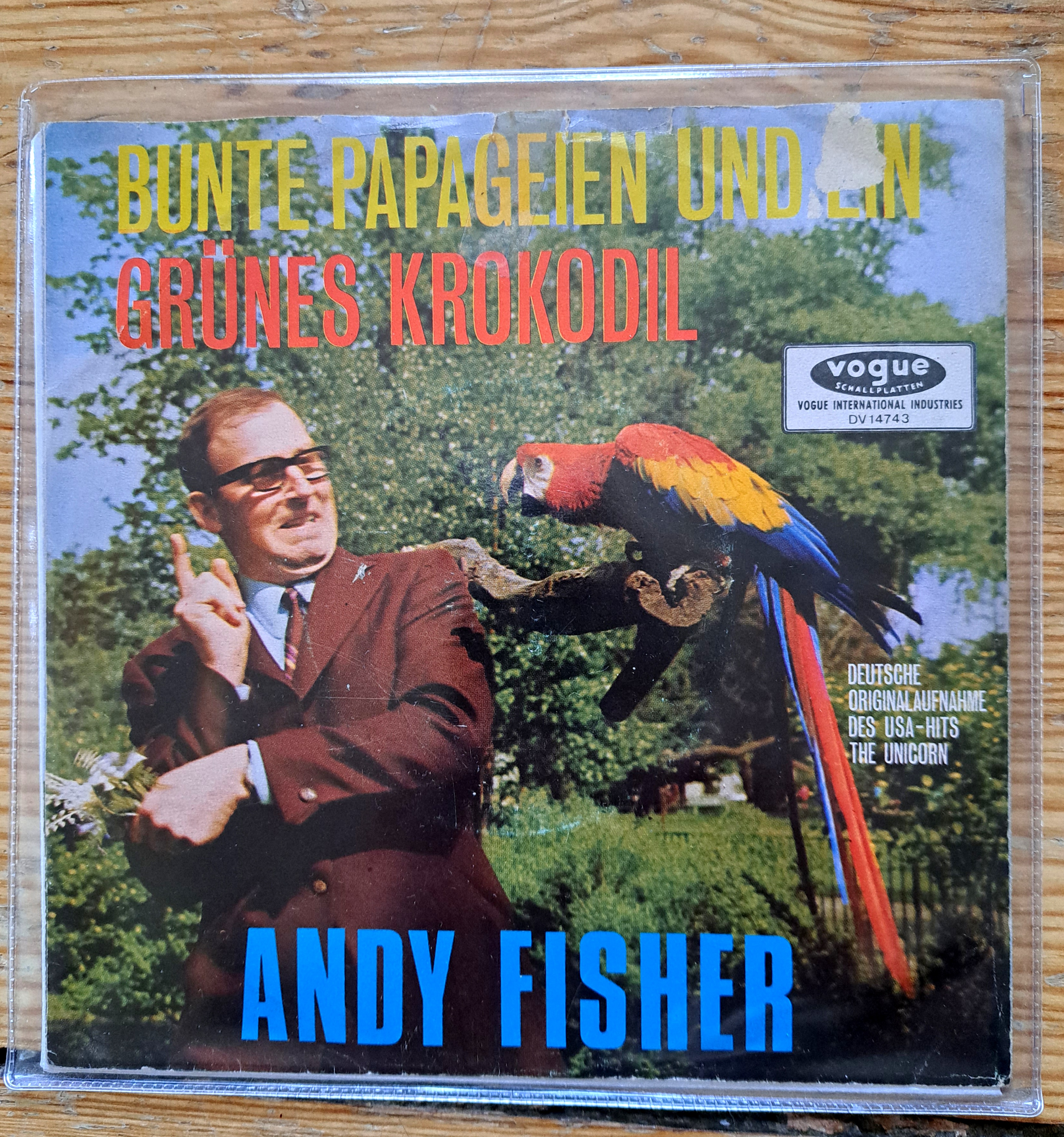
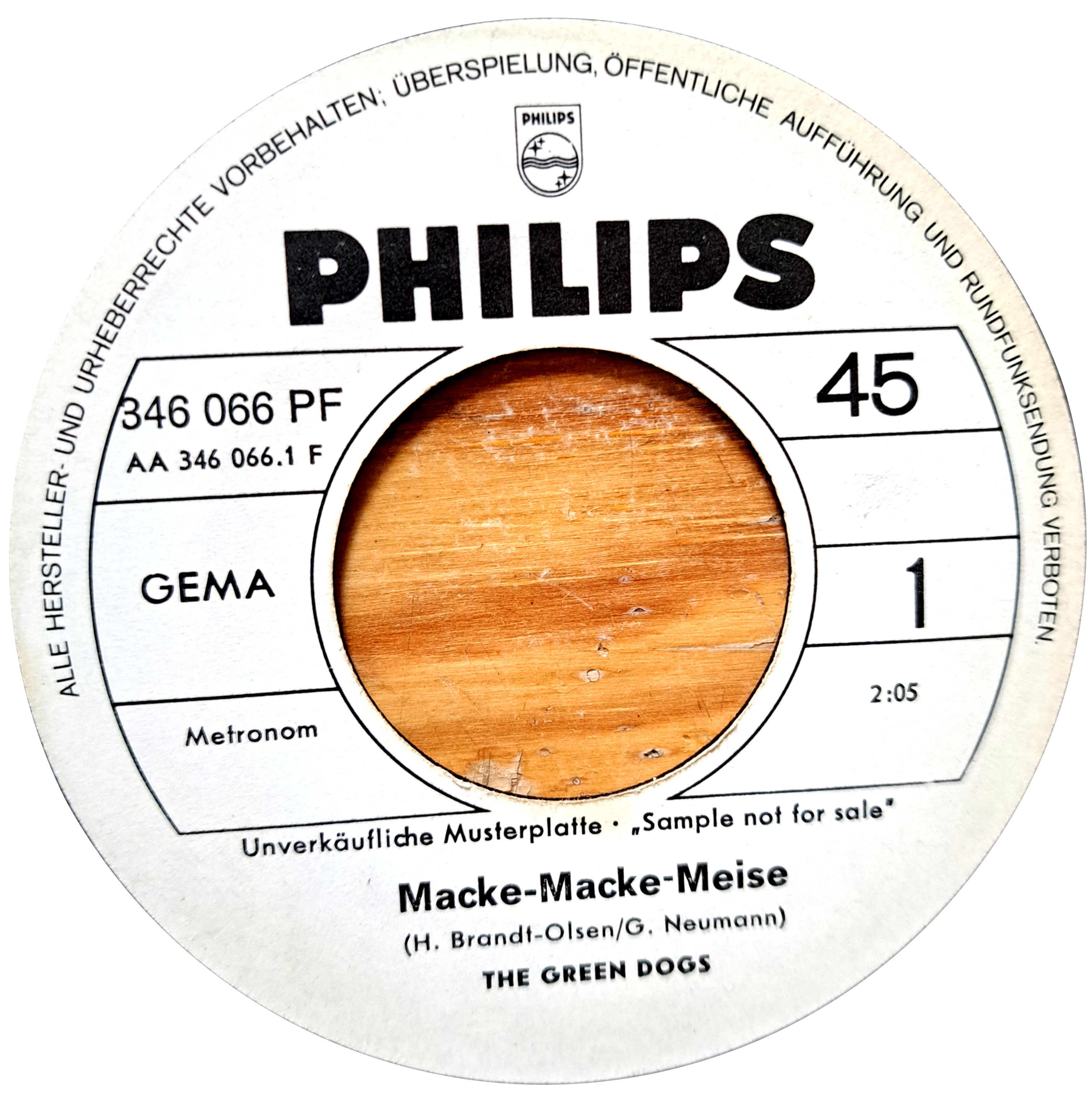

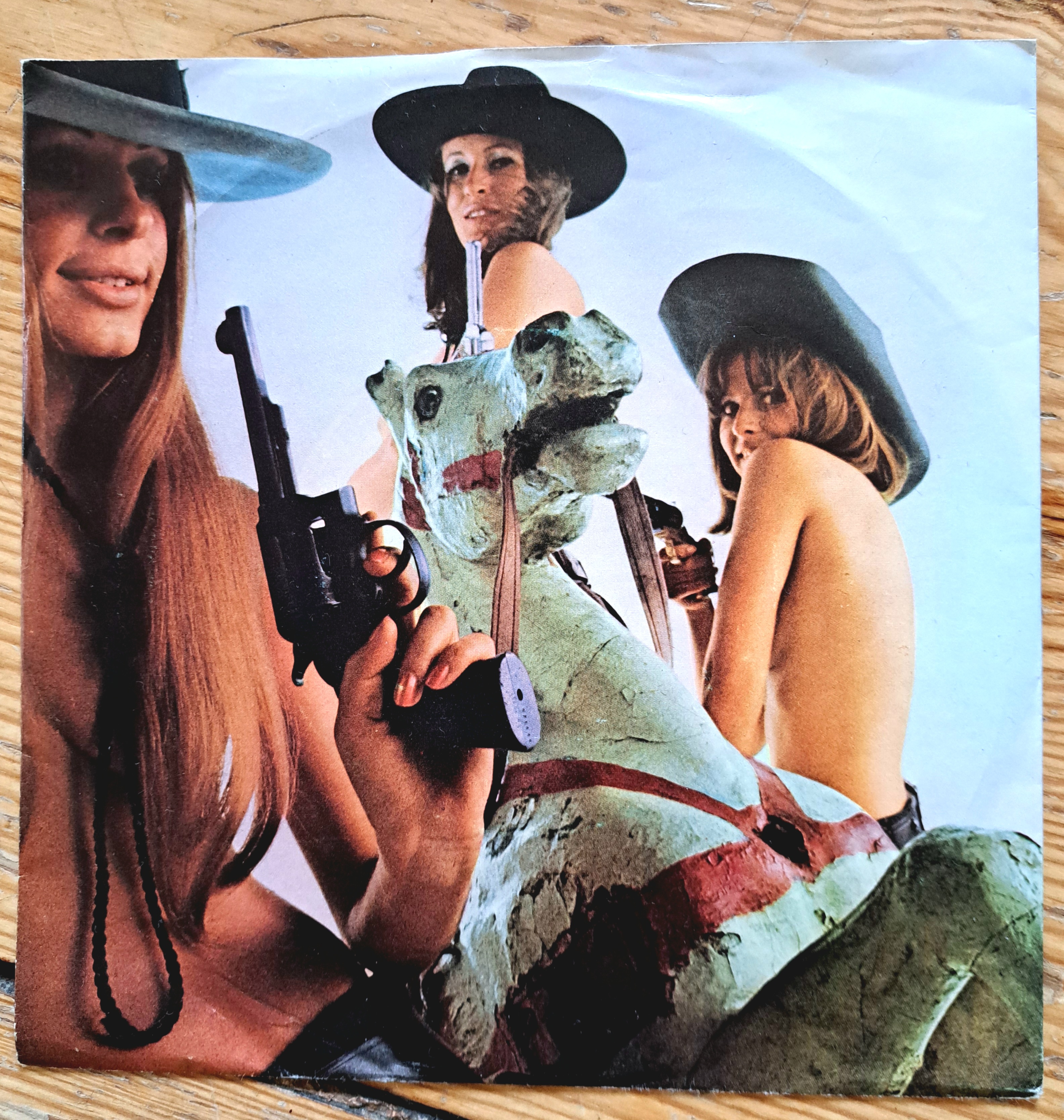
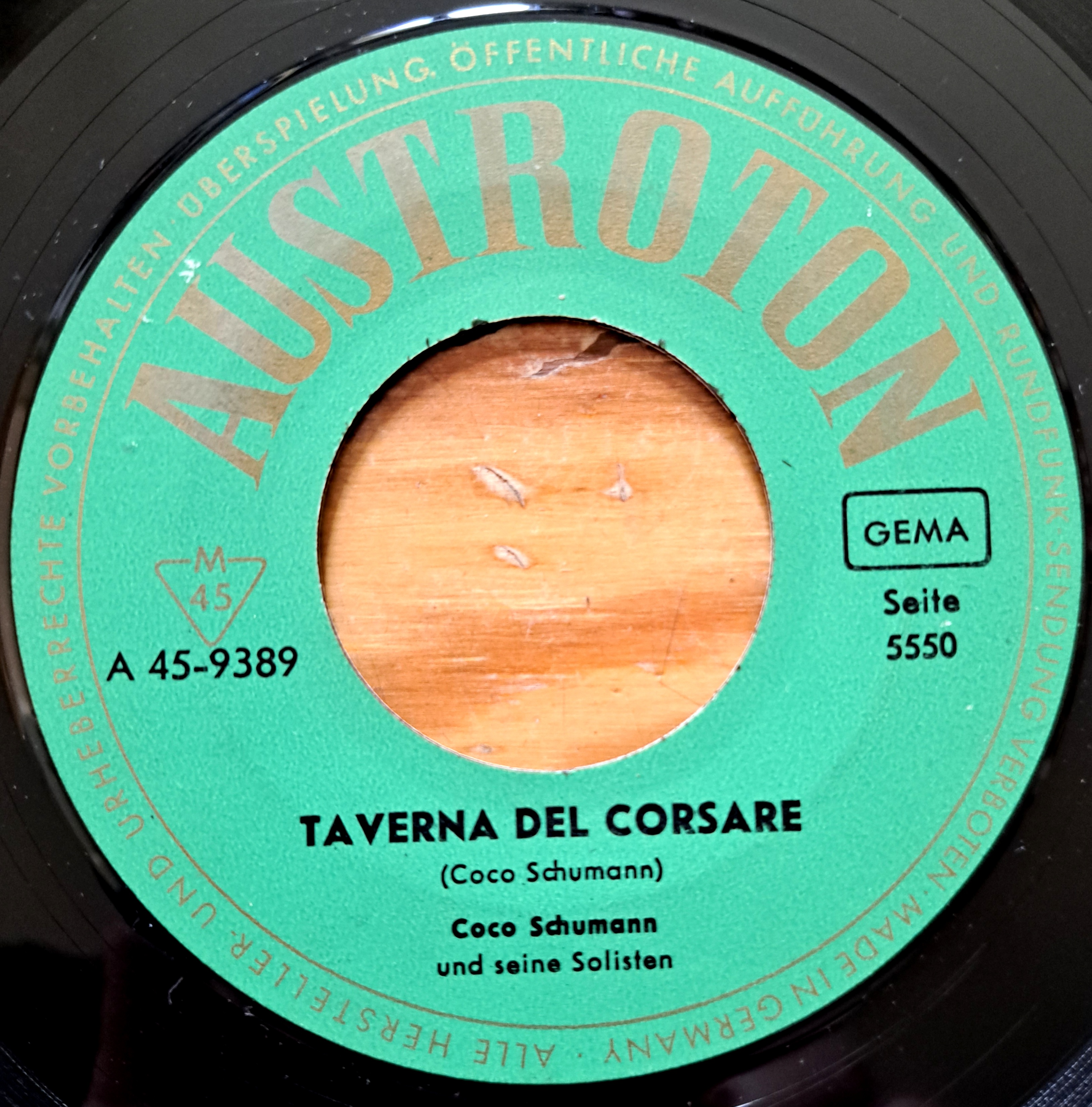
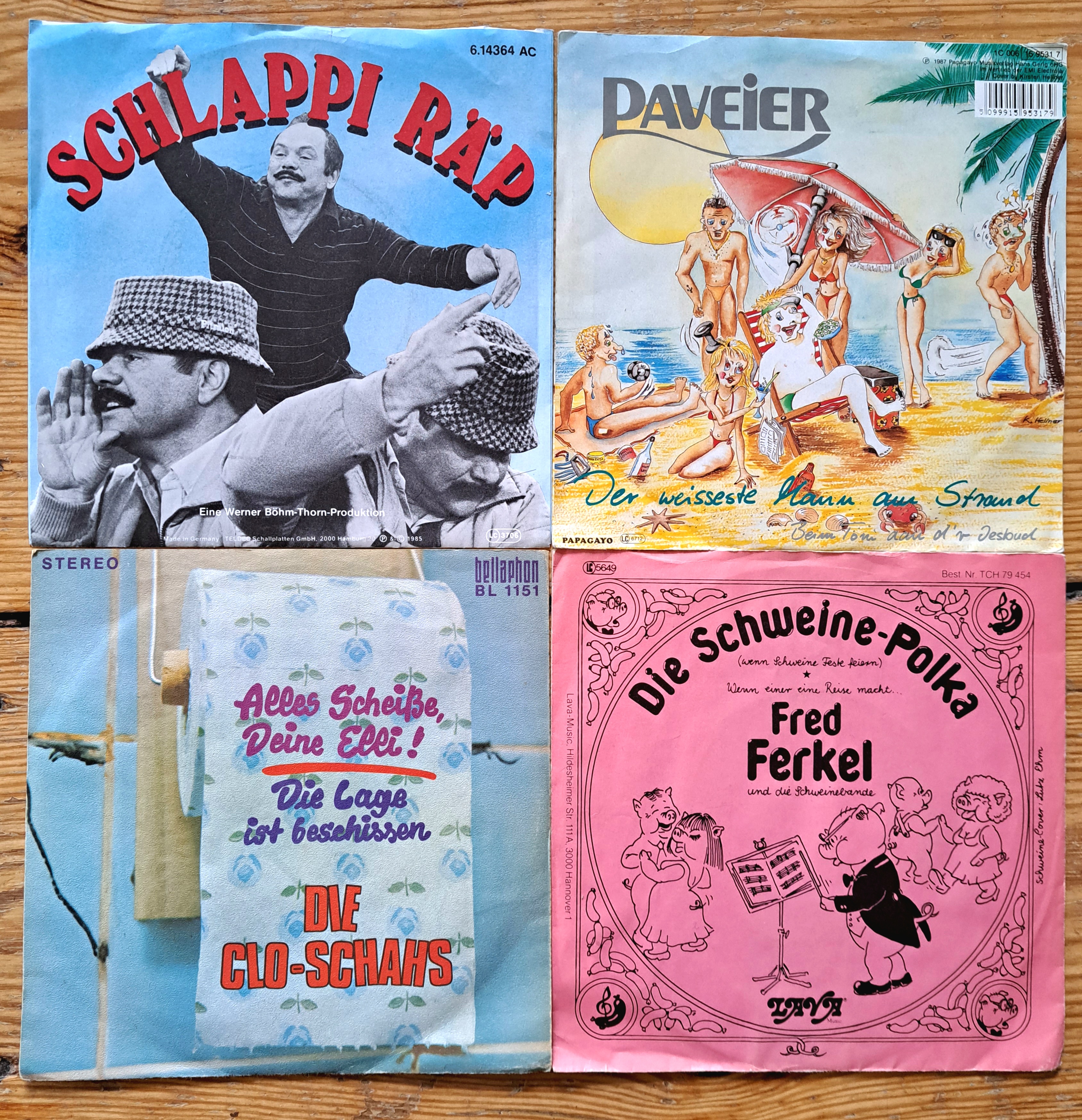
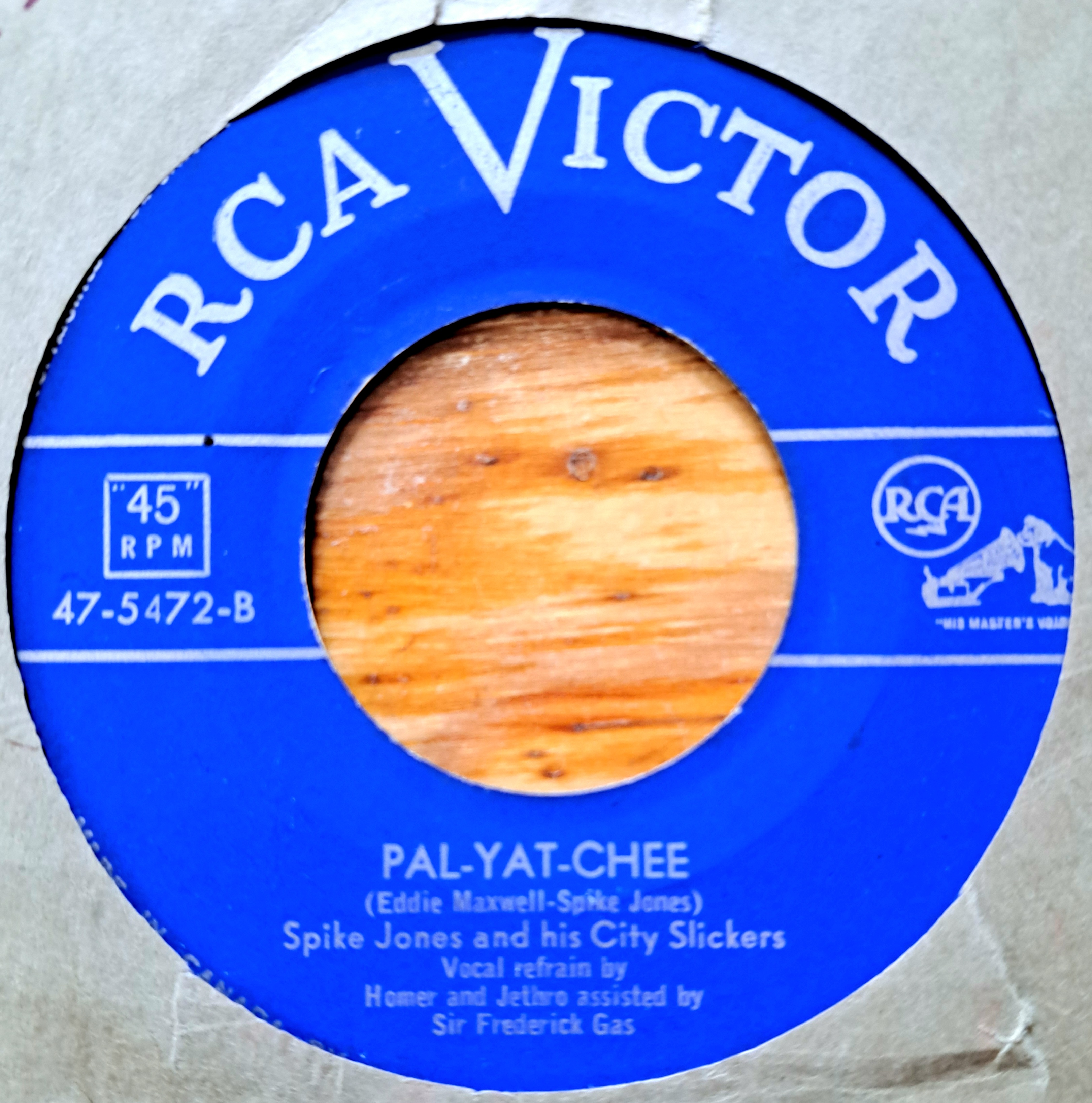
Bei uns in der kleinen Bar
Posted: April 5, 2018 Filed under: 50s, Cartoon Sleeves, Germany, Instrumental Records Leave a comment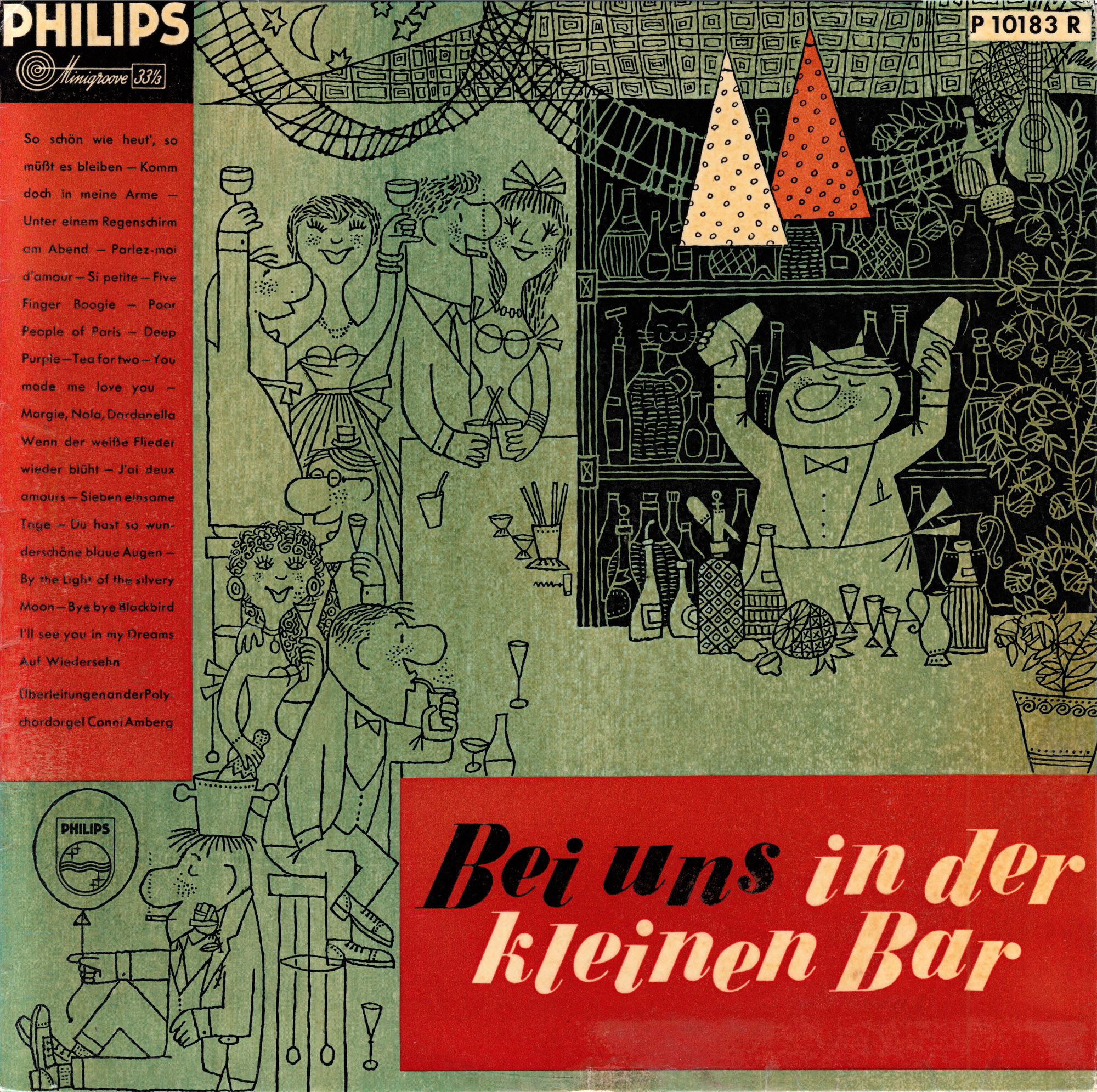
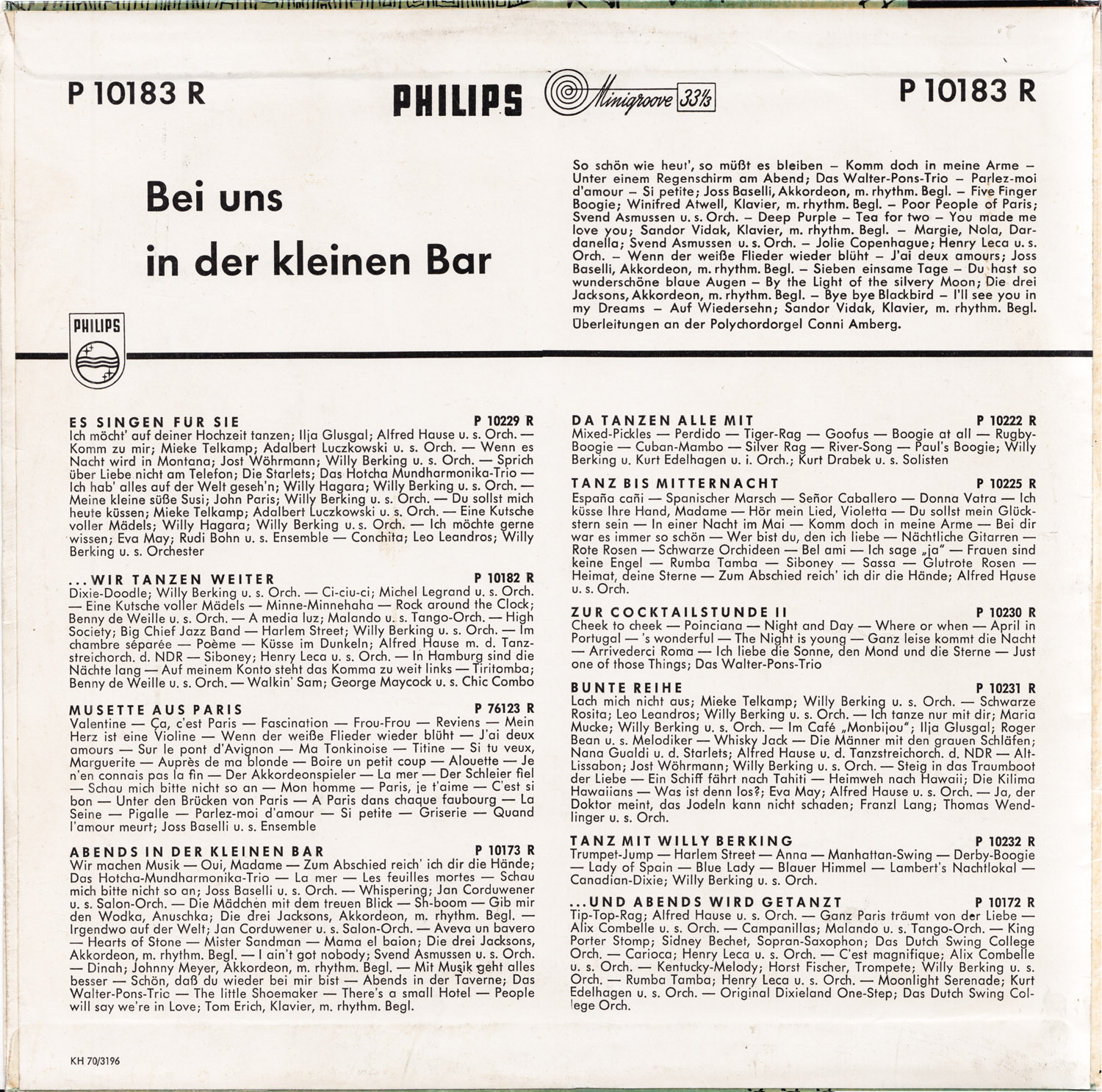
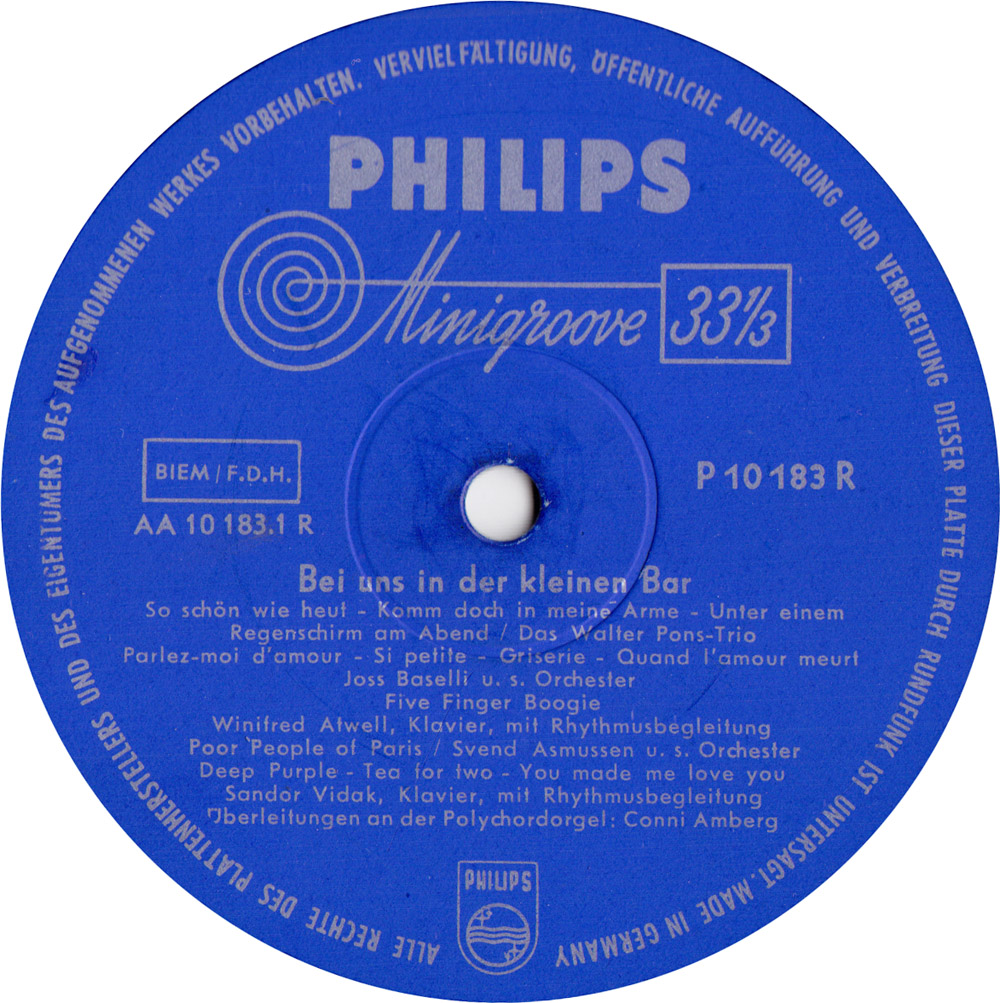
 I´ve loved the drawing style of Hans Jürgen Press since I was a child, so I recognized it immediately when I saw the album cover of this 10″. The clear, slightly broken lines, the big noses and the light-hearted humor are typical for this outstanding German artist. Probably because it was not directed towards children, the design is not as overcrowded with detail as his usual work. There is a well hidden small signature in the far upper right corner. Just as well hidden as the clues that Press was known for placing in his picture puzzles in The Adventures Of The Black Hand Gang.
I´ve loved the drawing style of Hans Jürgen Press since I was a child, so I recognized it immediately when I saw the album cover of this 10″. The clear, slightly broken lines, the big noses and the light-hearted humor are typical for this outstanding German artist. Probably because it was not directed towards children, the design is not as overcrowded with detail as his usual work. There is a well hidden small signature in the far upper right corner. Just as well hidden as the clues that Press was known for placing in his picture puzzles in The Adventures Of The Black Hand Gang.
The album is a showcase of the Philips label instrumental pop catalog, ca. 1955, in combination with a “bar” concept: added background noise, chatter, clapping, glasses clanking, interrupted by the Polychord organ of Conni Amberg. It´s like a radio play without the speakers – you hear only the background sounds.
My favorite track is a medley of Margie, Nola and Dardanella by Svend Asmussen and his orchestra. Danish jazz violinist Svend Asmussen died last year at the age of 100. In the 50s, Asmussen was influenced by the violinist Stuff Smith, but this medley sounds more like the guitar wizardry of Les Paul…
BEI UNS IN DER KLEINEN BAR, Margie-Nola-Dardanella Medley
I like this version with the added clapping better than the original version. You can listen and compare it here.
Initially, I didn´t want to post the whole album, because I thought it was boring. Then, after listened to it for a while, I found it to be strangely soothing. I guess, I´m into elevator music now…
BEI UNS IN DER KLEINEN BAR, Seite 1
BEI UNS IN DER KLEINEN BAR, Seite 2
Kenn´ Se den?
Posted: March 25, 2018 Filed under: 50s, Berlin Records, Cartoon Sleeves, Comedy, Flexible Records, Promotional Records 1 Comment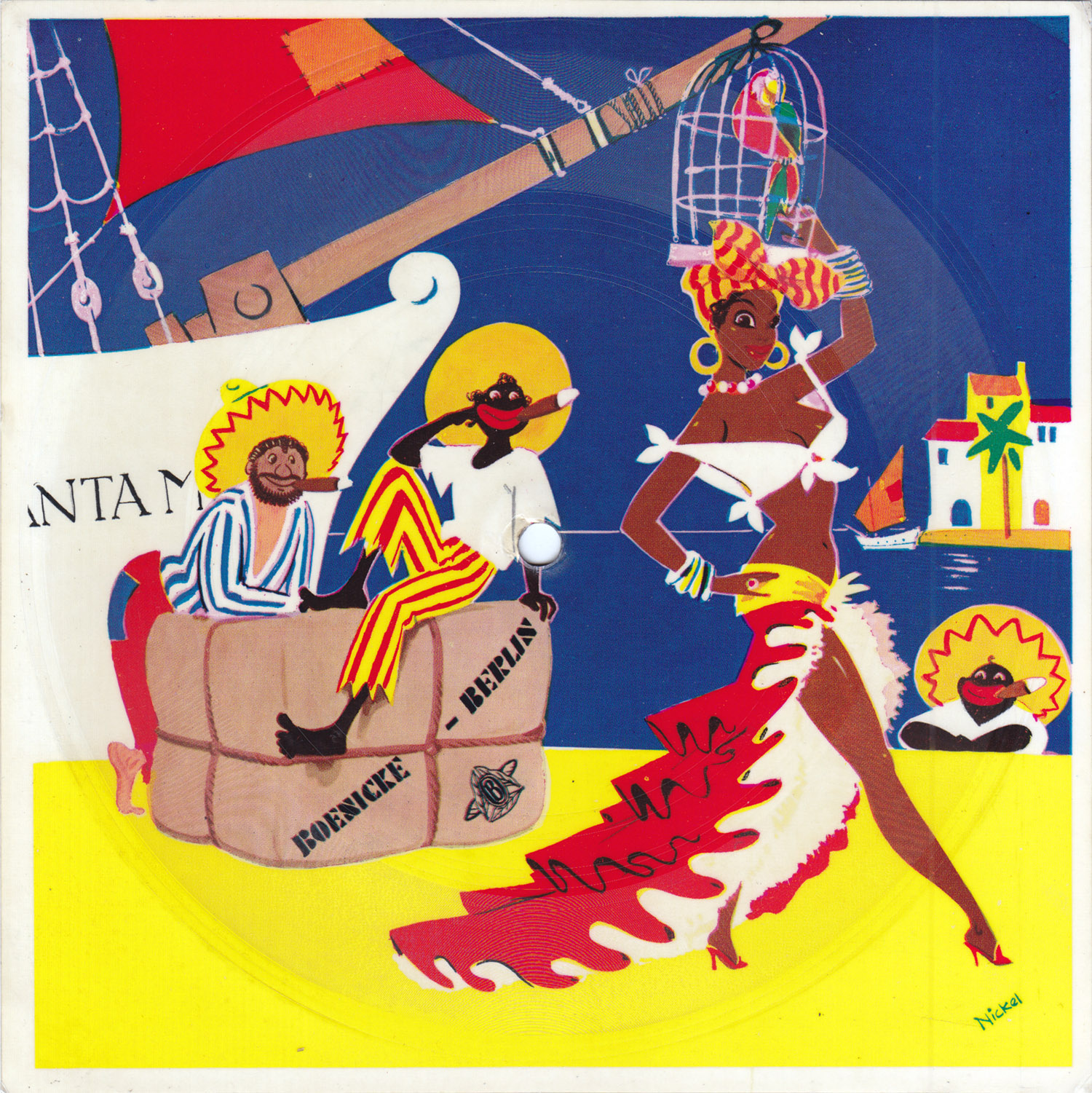
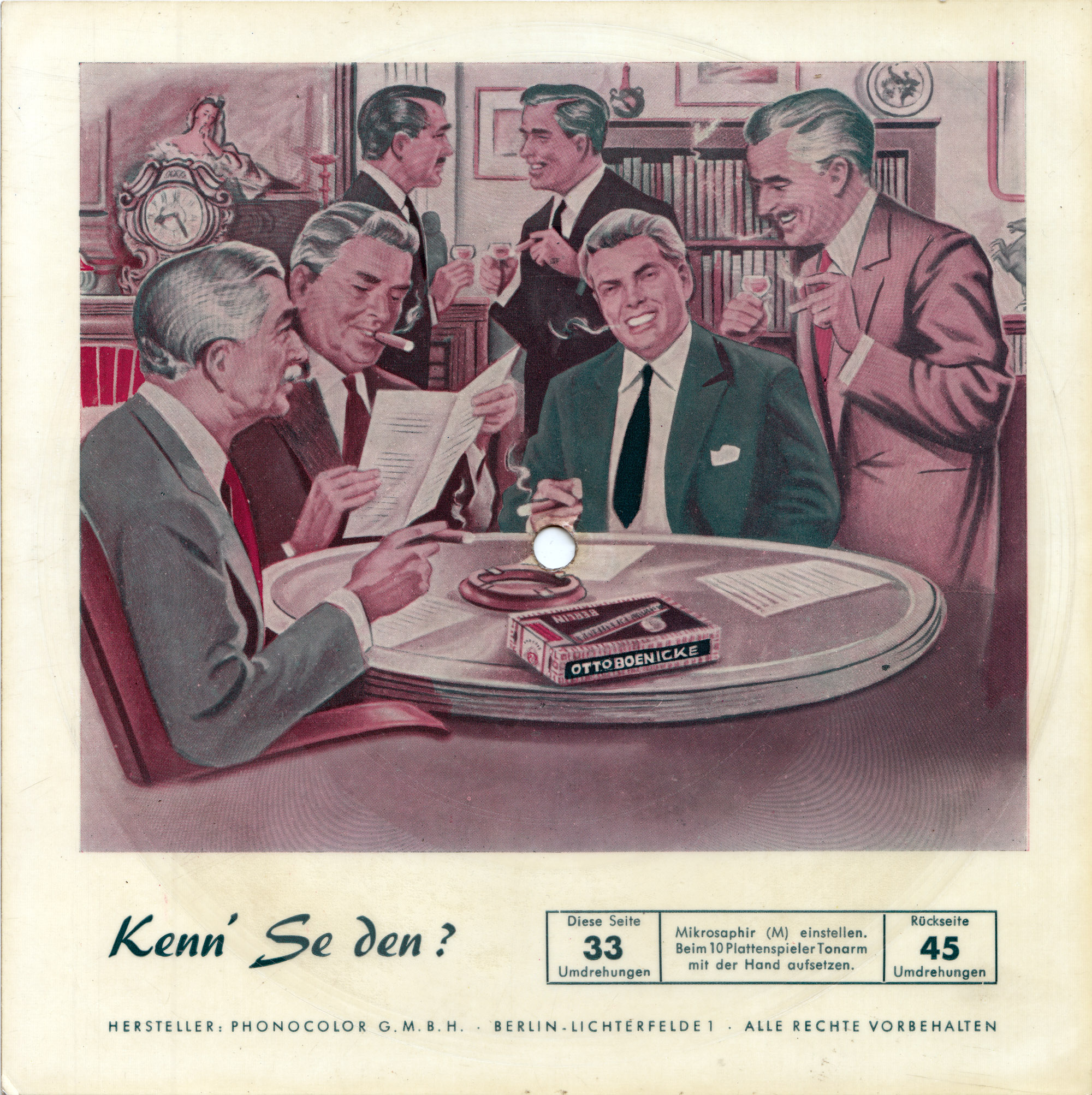 Two weeks ago, I found this record at a Berlin record convention. This promotional flexi-disc for the Berlin tobacco company of Otto Boenicke fits the framework of Berlin Beatet Bestes perfectly. The front side of the record was illustrated by Helmut Nickel. Nickel, an outstanding stylist in the German post-war adventure comic genre, was known for his instantly recognizable black and white pen work. This gouache style illustration shows, he was very good with color, too.
Two weeks ago, I found this record at a Berlin record convention. This promotional flexi-disc for the Berlin tobacco company of Otto Boenicke fits the framework of Berlin Beatet Bestes perfectly. The front side of the record was illustrated by Helmut Nickel. Nickel, an outstanding stylist in the German post-war adventure comic genre, was known for his instantly recognizable black and white pen work. This gouache style illustration shows, he was very good with color, too.
Born March 24, 1924 in Dresden, Helmut Nickel fought in WW II, was a prisoner of war for three years and left East-Germany for West-Berlin in 1948. To finance University, Nickel started illustrating various comics series in 1952. From 1952 to 1964 he worked on a whole series of comics, such as Robinson, Hot Jerry, Titanus, Die 3 Musketiere, Der Graf von Monte Christo and Peter’s seltsame Reisen.
( Robinson No. 84, page 11, 1958. From the collection of Hansi Kiefersauer.)
Informed by his studies, Nickel´s comics were educational, at a time when comics were still regarded as trash that was subverting the children. After finishing University in 1959, Nickel worked in a Berlin museum and then applied for a job at the New York Metropolitan Museum as a curator of the historical weapons collection. He stayed there until his retirement in 1989. Today he lives in Florida.
In 2011 Helmut Nickel was honored with a lifetime achievement award at the Munich Comic Festival. Yesterday, Helmut Nickel turned 94.
The Helmut Nickel-side of this flexi is a tongue-in-cheek narration admiring the beautiful brown body of a Boenicke cigar…
Boenicke-Rumba (The song doesn´t have a title. I just called it that.)
Like many flexi discs that I´ve posted over the years this was also published by the Phonocolor company of Berlin-Lichterfelde. Phonocolor also issued the Okay Exquisit, Rondo and Topas labels.
While the Rumba-side runs at 45 rpm, the side with the cigar smoking middle-aged gentlemen runs at 33 rpm. Compared to the comissioned front, this looks like a stock illustration. The male and female narrators sound like Berlin cabaret Die Stachelschweine. Five jokes interrupted by some boogie woogie piano. Kenn´ Se den? Have you heard this one? …
SUSKE & WISKE, De Regendag, 1978
Posted: October 3, 2016 Filed under: 70´s, Belgium, Cartoon Sleeves, Comics, Flexible Records, Promotional Records 3 CommentsIt´s been raining quite a bit here in Brussels over the past days, so here´s a record about “A Rainy Day”. Suske & Wiske is one of the most famous and successful Belgian comics series. Since its creation in 1945, it sold 145 million copies. This promotional multi-media item for kids, produced for German food brand Knorr, is a good example of Belgian multilingualism. Side A is in Flemish and side B is in French. The four-page comic insert also has speech balloons in both languages, so you can read along while you listen to the record.
If this very thin Flexi-Disc only contained spoken word adventures of Suske & Wiske, I wouln´t have recorded them. Instead, there´s a funny little tune mixed into the story. Kinda power-pop meets nerve-racking noise…
SUSKE & WISKE, De Regendag, 1978
BOB & BOBETTE, La Pluie, 1978
JOY UNLIMITED, Der Top-Hit von Topset, 1974
Posted: February 29, 2016 Filed under: 70´s, Cartoon Sleeves, Germany, Promotional Records Leave a commentA krautrocker´s chocolate bar? The Topset chocolate bar seems to have vanished from the market quickly, at least I can not remember it and I was 8 years old in 1974, a perfect customer for chocolate bars. I guess I was more into Kinderschokolade.
Here´s the Mannheim krautrockers Joy Unlimited, minus the vocalist they named themselves after – Joy Fleming, the inventor of German Soul singing.
I posted another promotional 45 by Joy Unlimited in 2008.
“Was heisst´n das, groovy?”
“Topset ist groovy!”
JOY UNLIMITED, Das neue Topset, 1974
JOY UNLIMITED, Qua Qua Pa Pa Qua, 1974
Nice water color drawing here on the sleeve, but with a classic “mistake” by the artist. Whenever I have drawn guitars like this, the musicians complained: ” That´s wrong! Why do the guitars have no strings?”
Die Herren Damen laden ein!
Posted: September 2, 2015 Filed under: 70´s, Adult, Cartoon Sleeves, Germany, Private Pressings 1 Comment

 The packaging of this 45 is pretty typical for privately pressed records – white, wrap-around paper “sleeve” and plain label colour and graphics. Everything else about this EP is out of the ordinary. The release in the early 1970s, coincides with the legalisation of homosexuality in Germany in 1971 and that of pornography in 1972.
The packaging of this 45 is pretty typical for privately pressed records – white, wrap-around paper “sleeve” and plain label colour and graphics. Everything else about this EP is out of the ordinary. The release in the early 1970s, coincides with the legalisation of homosexuality in Germany in 1971 and that of pornography in 1972.
The” girls” of the Travestie-Cabaret “Die Herren Damen laden ein” ( The Gentlemen Ladies invite you!) perform two jazz-standards and two risqué songs. Or actually, two lyrically graphic and pretty bold songs about sex. The name of the label says it all: SEX-Record.
Still, this is all quite humorous and softened by the cute vocals of the anonymous cross-dressing “Gentlemen-Ladies”. No clue who actually performed this, nor when or where. However, the songwriters of Die erste Nummer were Bert Loskaibraphonist Graf Porno Mit Seinem Herrenclub “Intime 8” in 1970.
Die erste Nummer ist die Allerschönste (The first time is the best) questions the unrealistic display and frequency of sex actions in the flood of sex films that followed the lift of the ban of pornography. A wonderful musical time capsule of Berlin’s gay nightlife in the early 70s…
GLORIA DUVAL, When You´re Smiling
Die schlechteste Schallplatte der Welt (dazu noch ohne Rückseite!)
Posted: April 19, 2015 Filed under: 60s, Cartoon Sleeves, Comedy, Germany Leave a comment





 “The worst record in the world (On top of that without a flip side!)”
“The worst record in the world (On top of that without a flip side!)”
Okay, that´s not true. If it was, you would probably have heard about it. It´s a pretty nice German novelty record with a cartoon sleeve. Perfect for Berlin Beatet Bestes. And, the flip and the back of the sleeve are indeed blank.
The label, that says “Lachplatte” (Laughing Record) and the Art Nouveau-style of the lettering, suggest that the song is based on the idea of The original Okeh Laughing Record: a man and woman laughing uncontrollably about a musician playing out of tune. For whatever reason, this song has very little laughing, but a lot of out of tune playing.
I assume, that the Kleckerdorfer Symphonieorchester is actually Rolf Schneebiegl´s brass band. Scheebiegel (1924-2004) was quite an interesting musician who played jazz after WWII with Freddie Brocksieper, Kurt Edelhagen and Hans Koller, before he started his own very successful brass band, the Original Schwarzwaldmusikanten. While it might not work as a re-make of the famous Laughing Record, fans of classical music might still find humor in this rendition of Franz von Suppe´s “Dichter und Bauer”, as arranged by Rolf Schneebiegl.
There´s some crafty voluntary out of tune playing to be heard…
DAS KLECKERSDORFER SYMPHONIEORCHESTER, Dichter und Bauer
The reason I bought this record, was the sleeve, designed by cartoonist Reinhard Streit. I found no information about him online at all.
However, I found four cartoons by Reinhard Streit in my collection, published in the small book “Ohne Worte” (Without Words) in 1956 by Verlag Kurt Desch. The company published a European, a French and a German cartoon anthology. This is from the German edition:
Patentamt (patent office)
HERMANN SATTLER MIT SEINEM ORCHESTER, Blasmusik, 1965
Posted: April 14, 2015 Filed under: 60s, Adult, Cartoon Sleeves, Comedy, Germany Leave a comment

 Even more dirty schlager songs by the tiny Cady label. The illustration on the sleeve was drawn by the same anonymous artist that did the Helga Mohr sleeve.
Even more dirty schlager songs by the tiny Cady label. The illustration on the sleeve was drawn by the same anonymous artist that did the Helga Mohr sleeve.
HERMANN SATTLER MIT SEINEM ORCHESTER, Blasmusik, 1965
HERMANN SATTLER MIT SEINEM ORCHESTER, Wenn du Lust hast, komm zum Kegeln, 1965


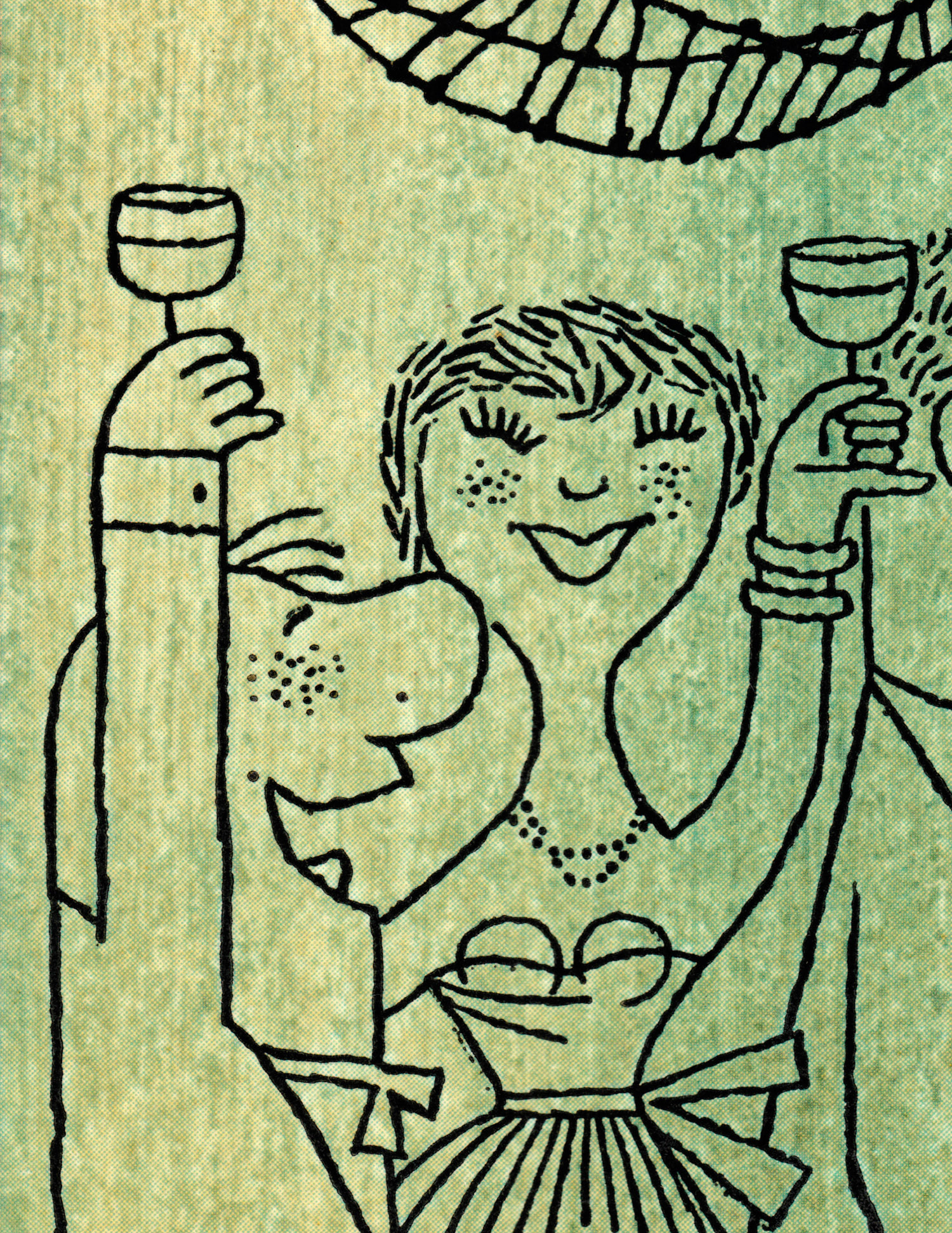
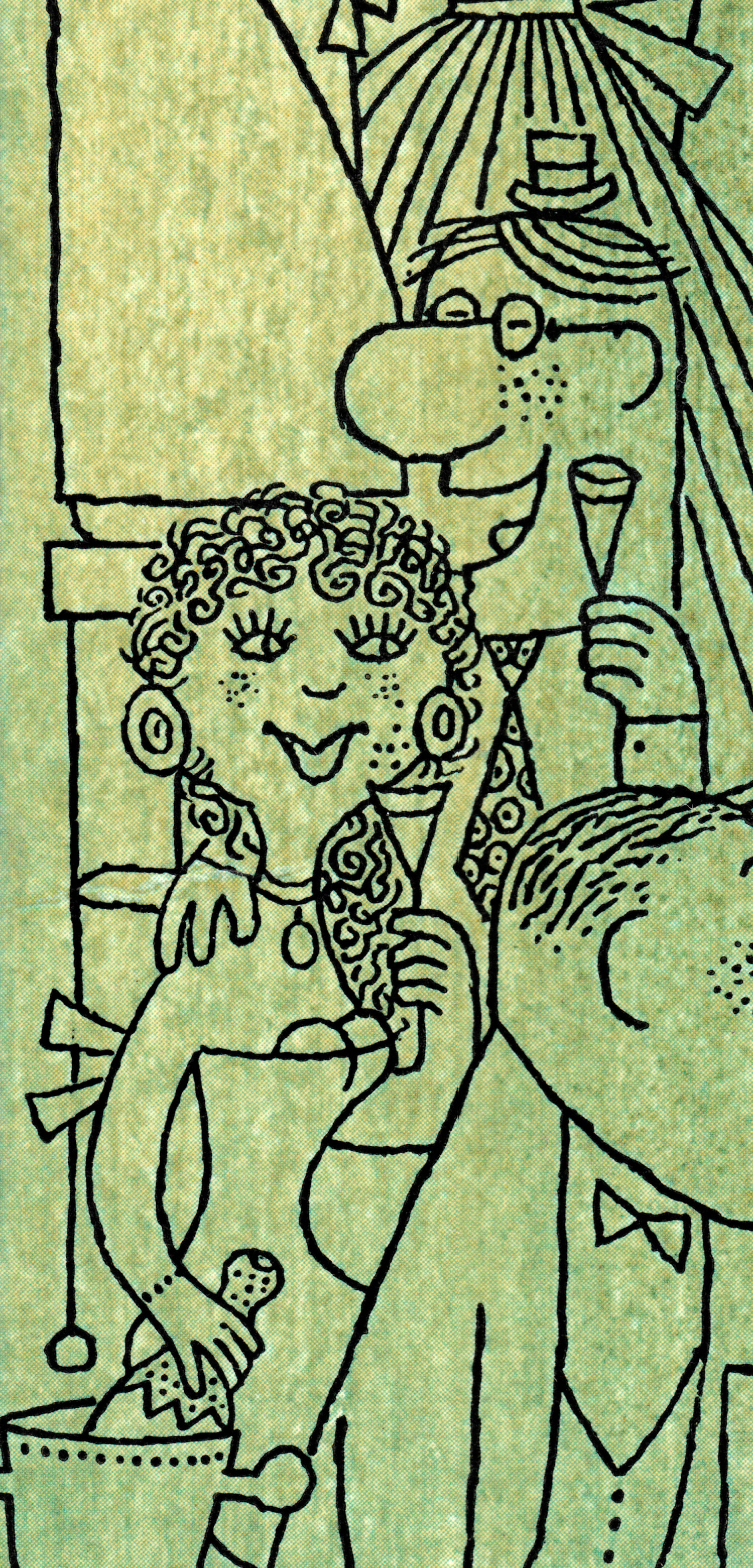
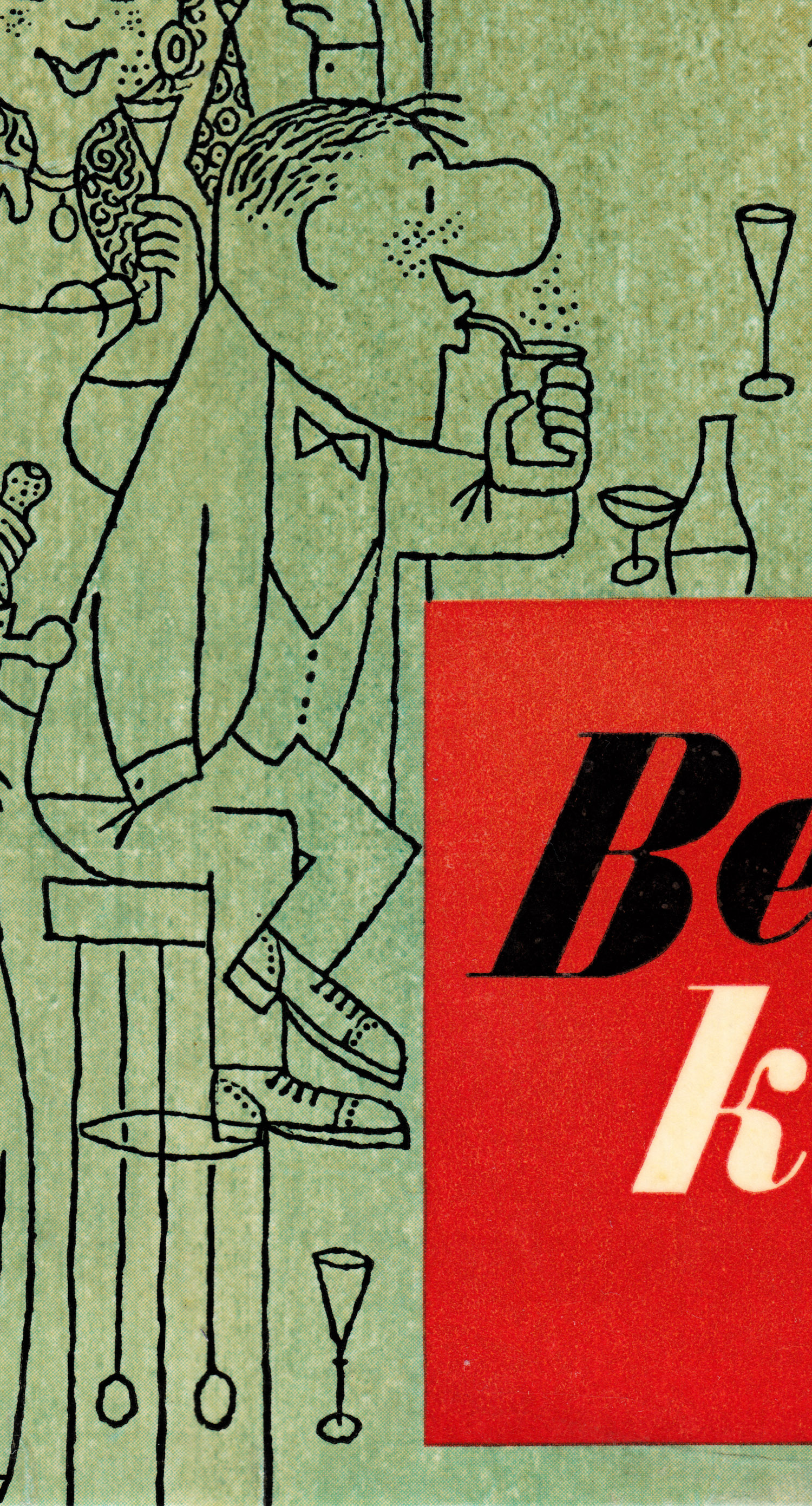
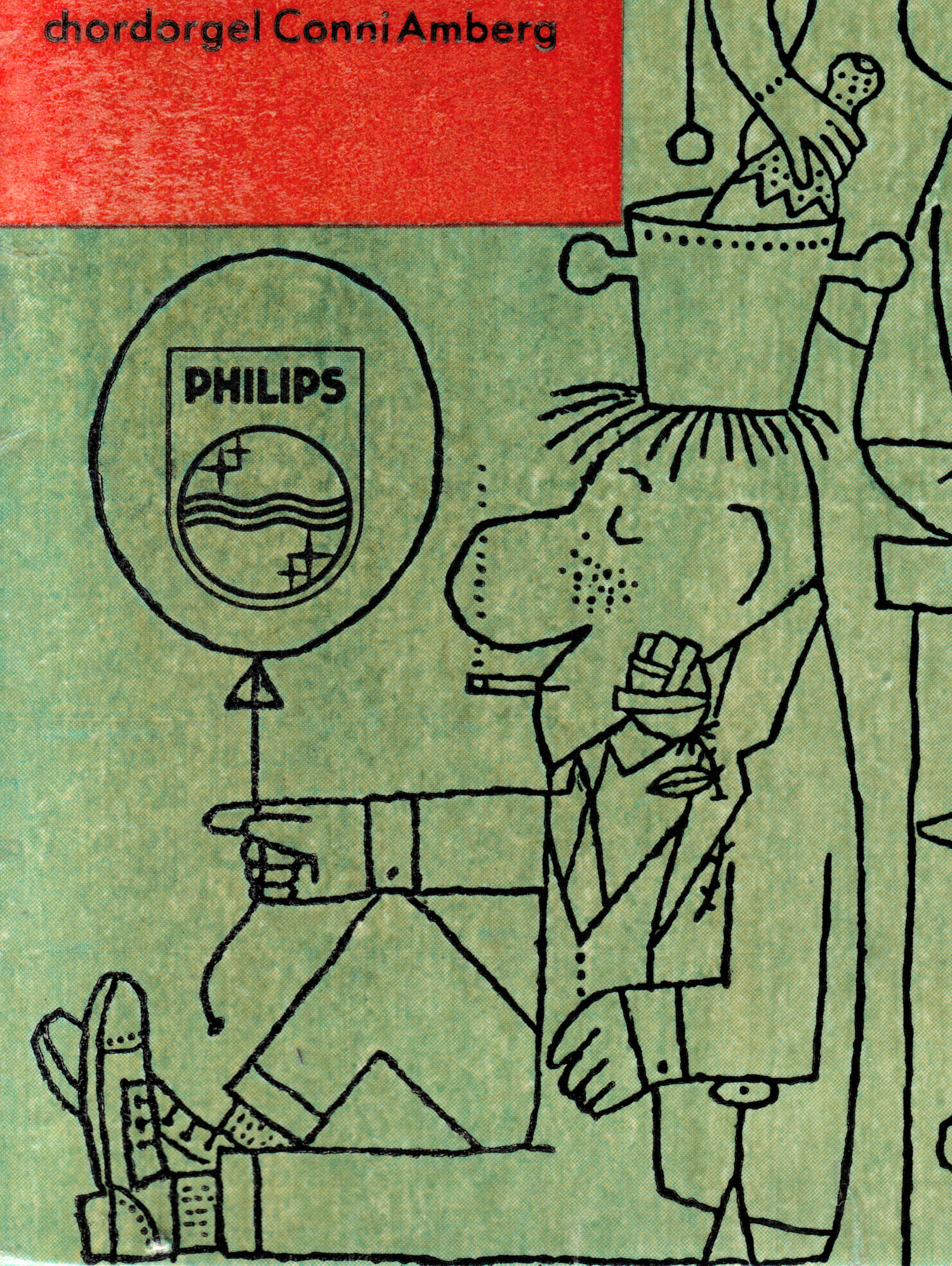

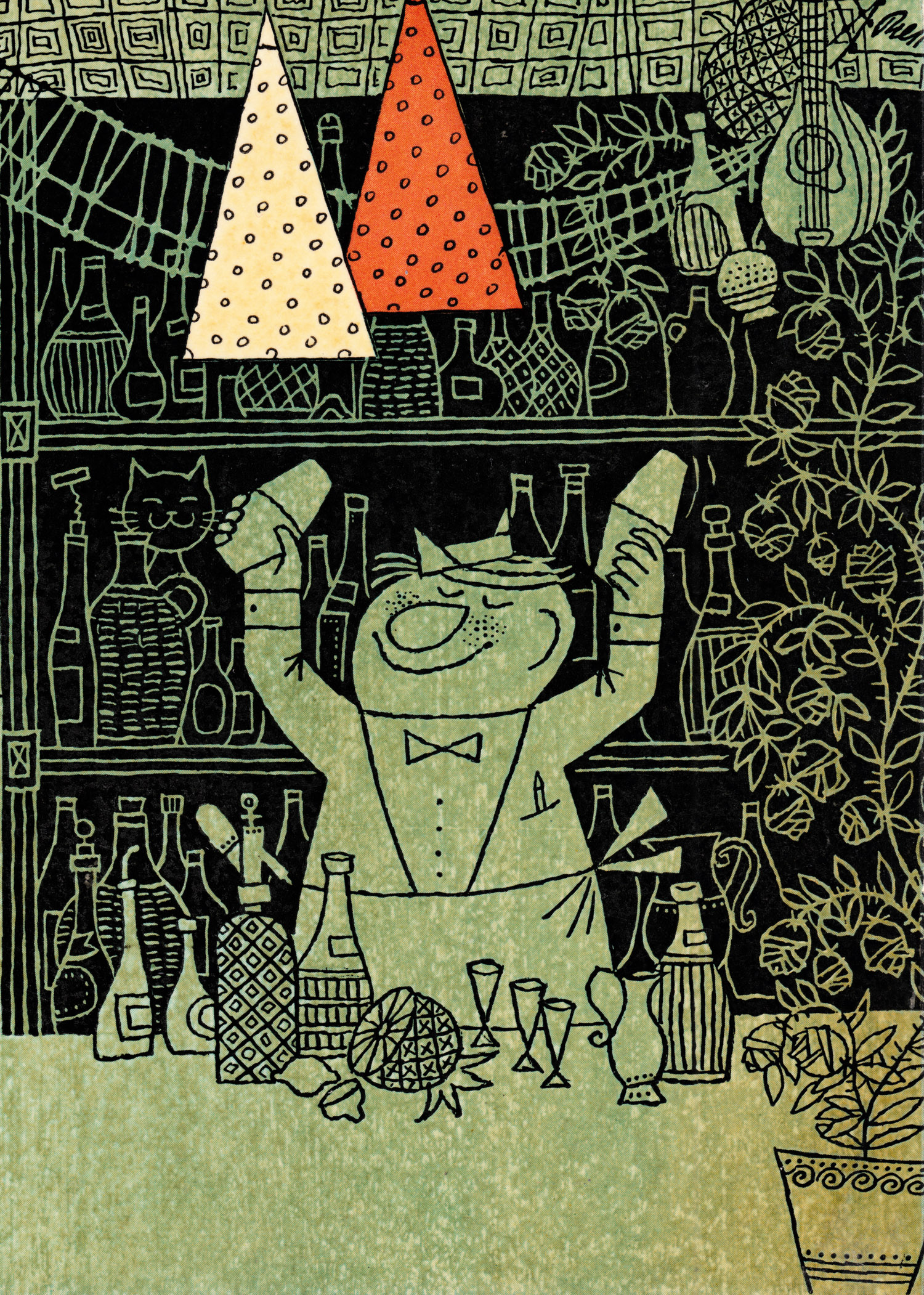
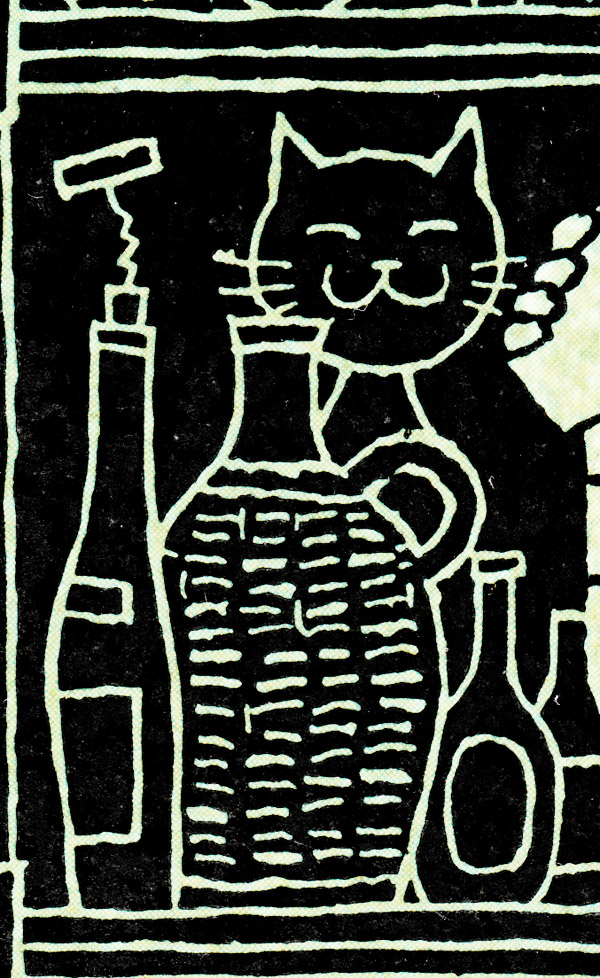
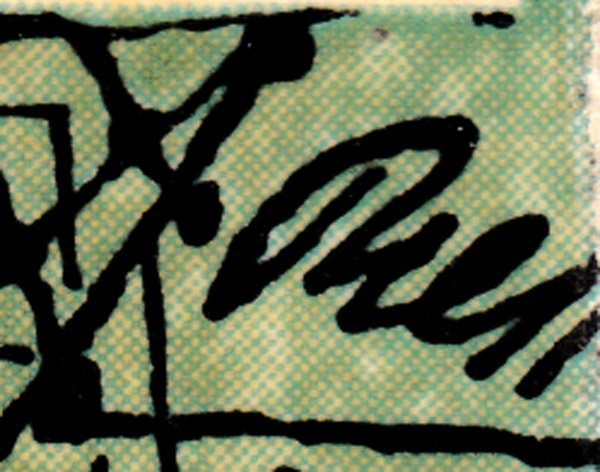
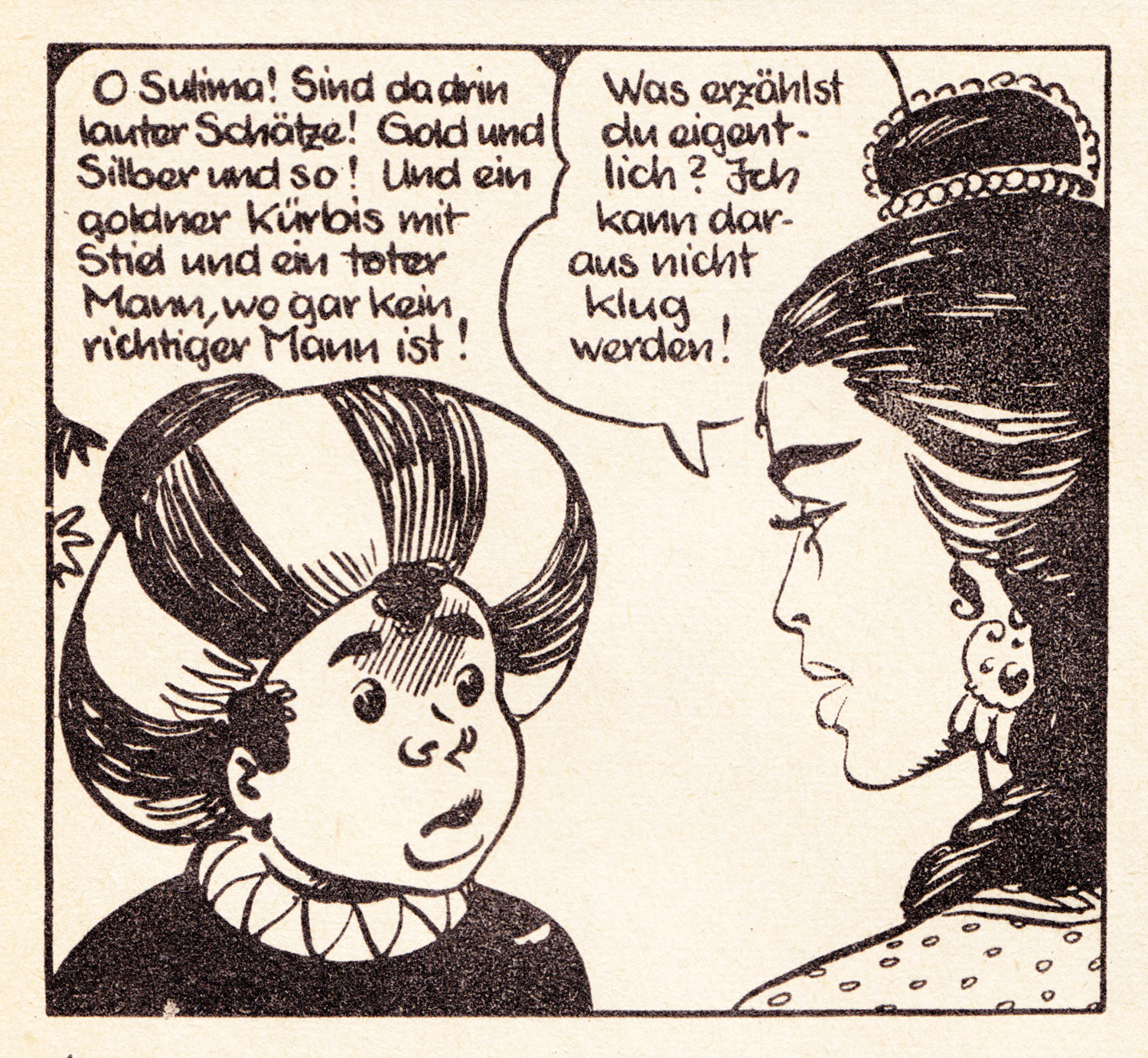

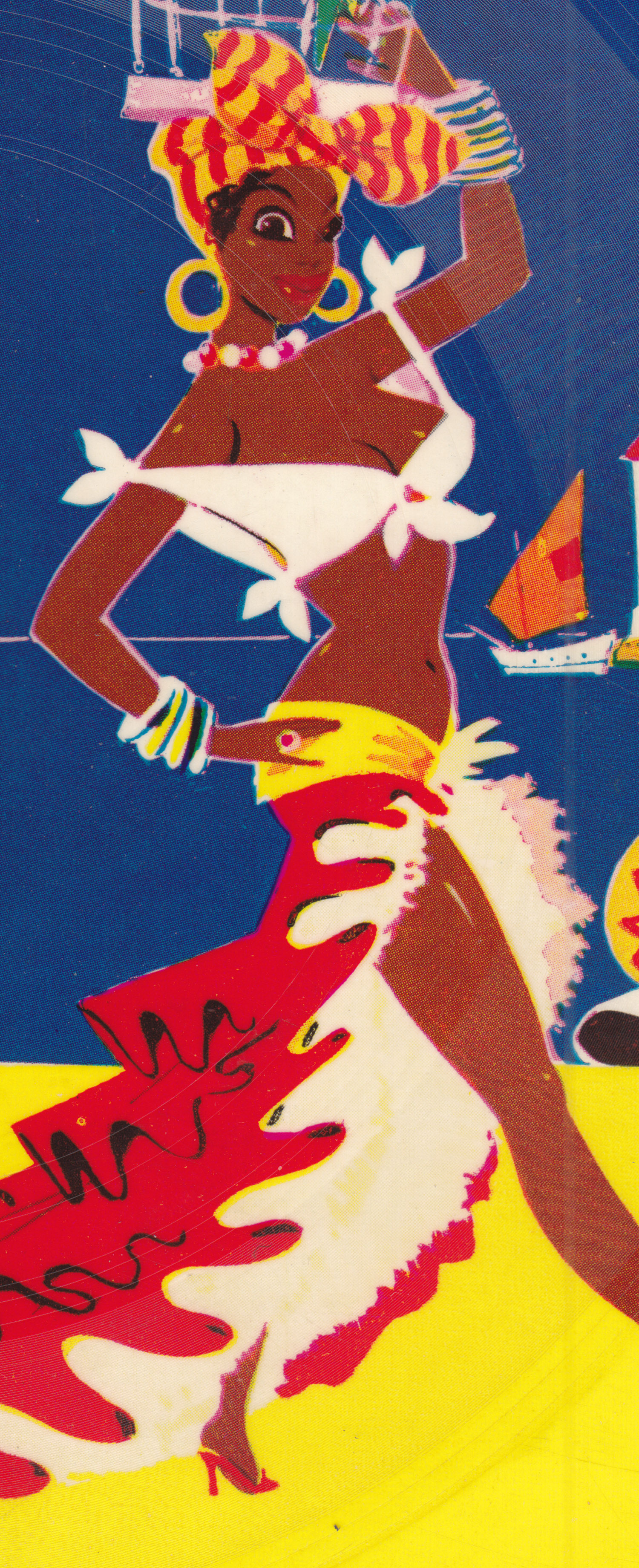
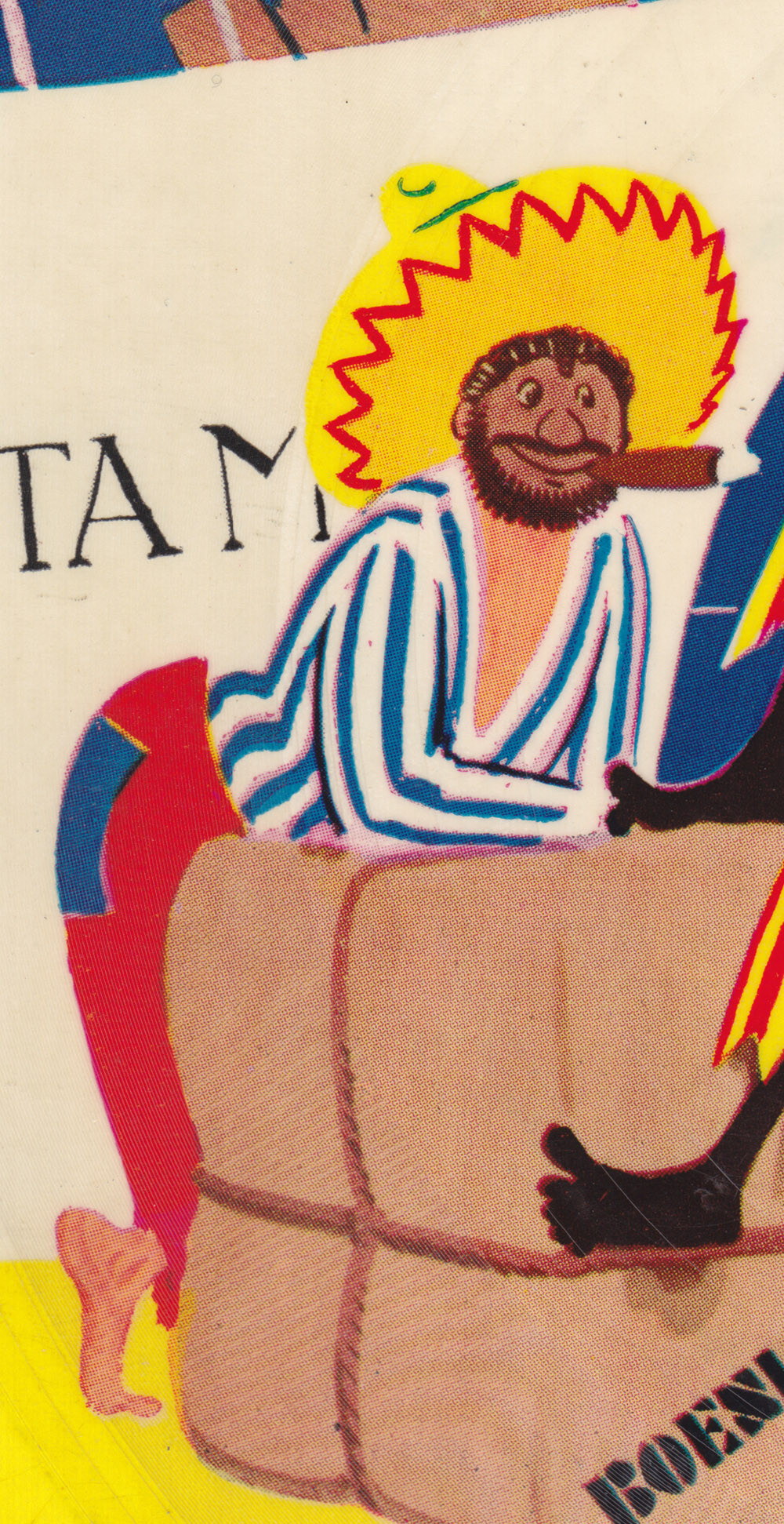


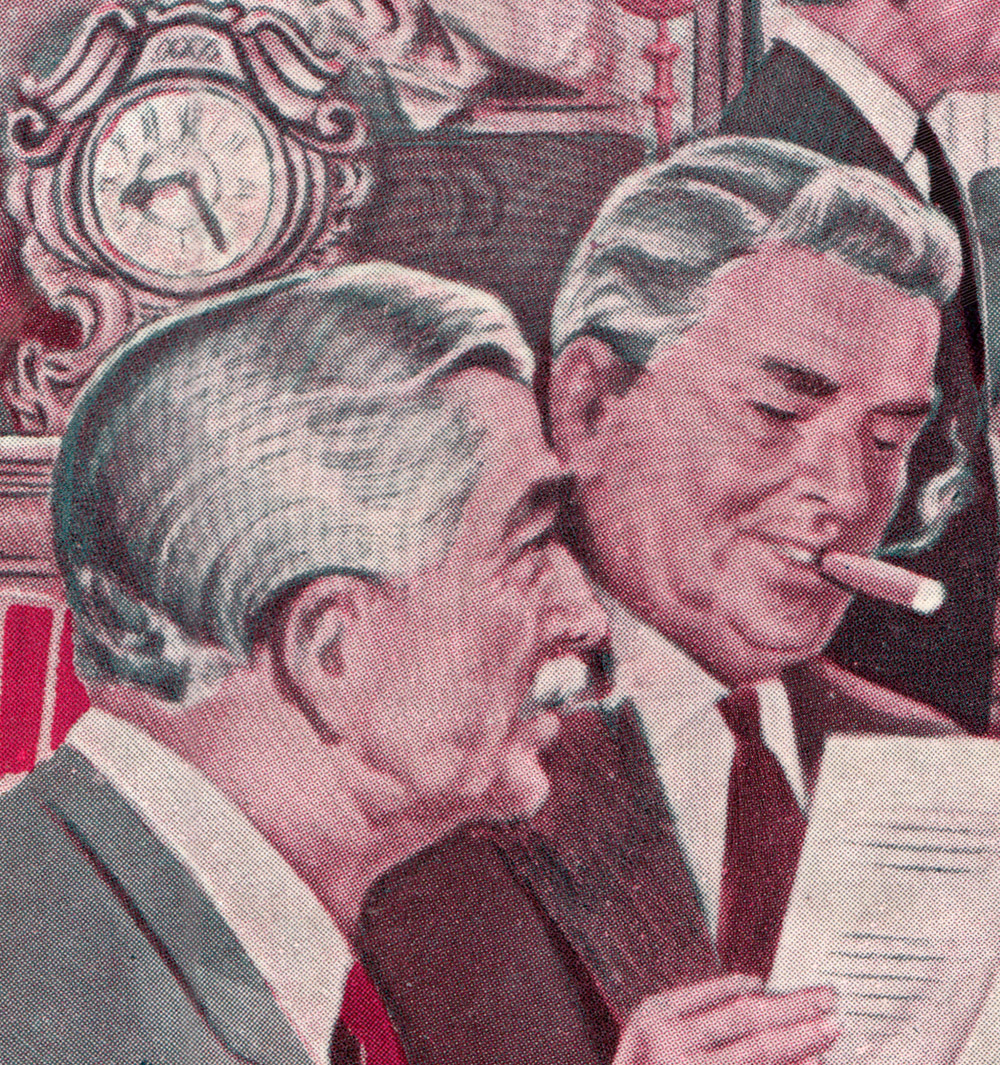
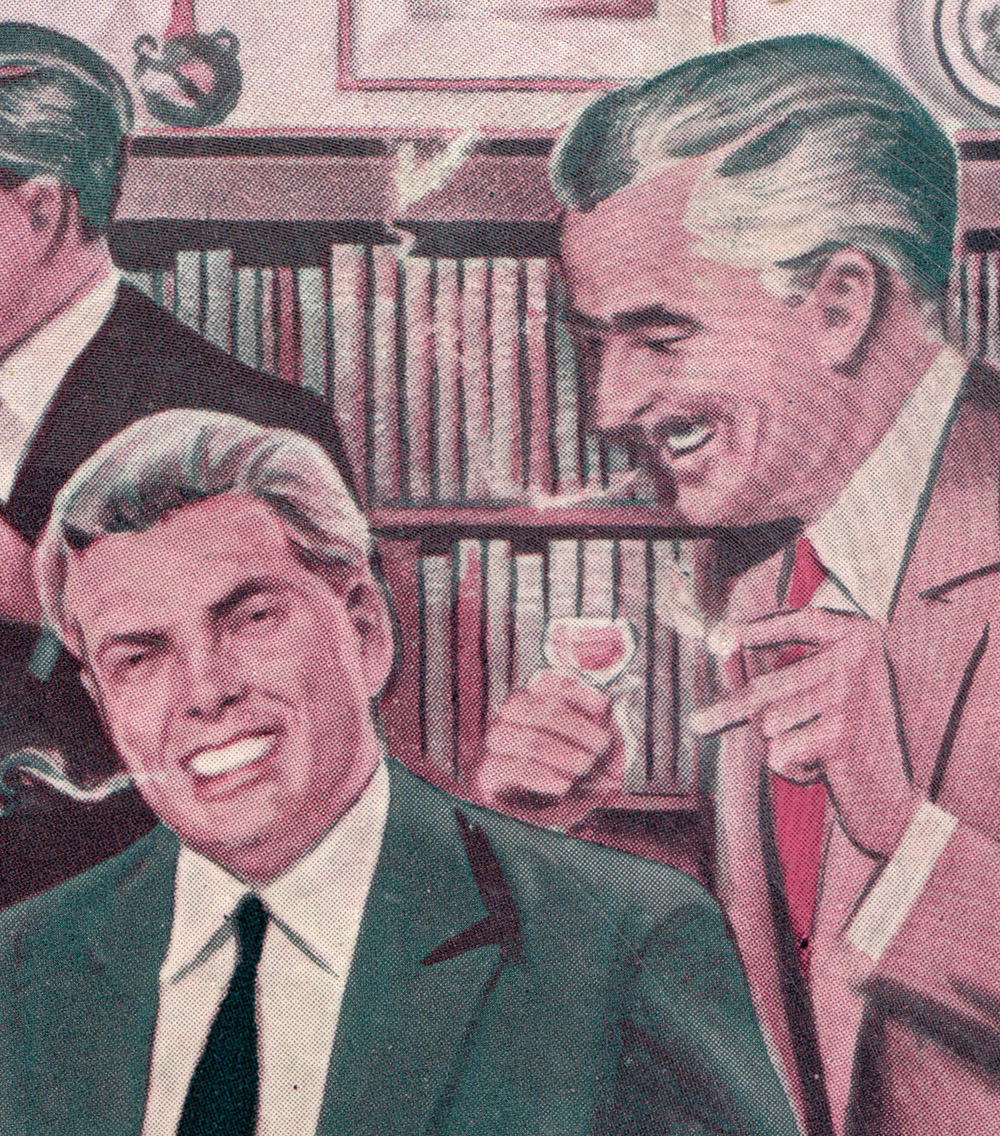
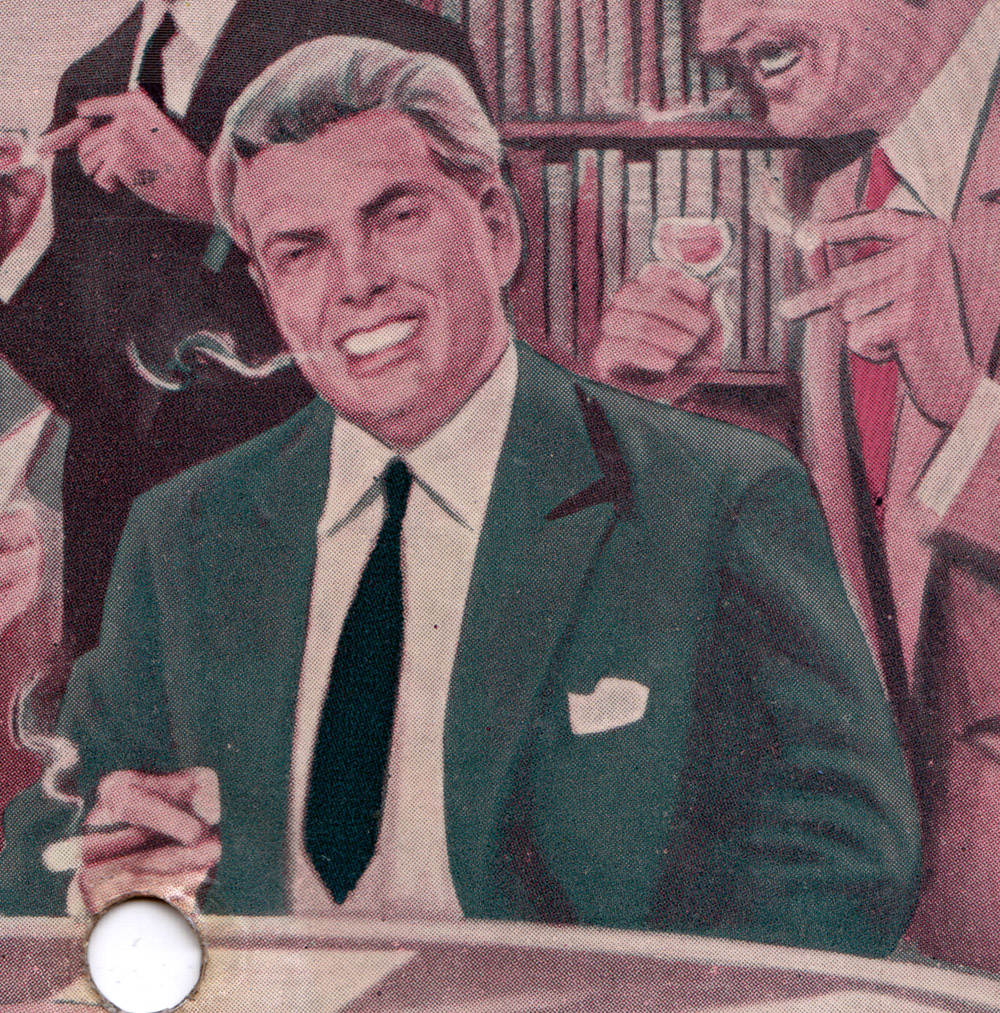
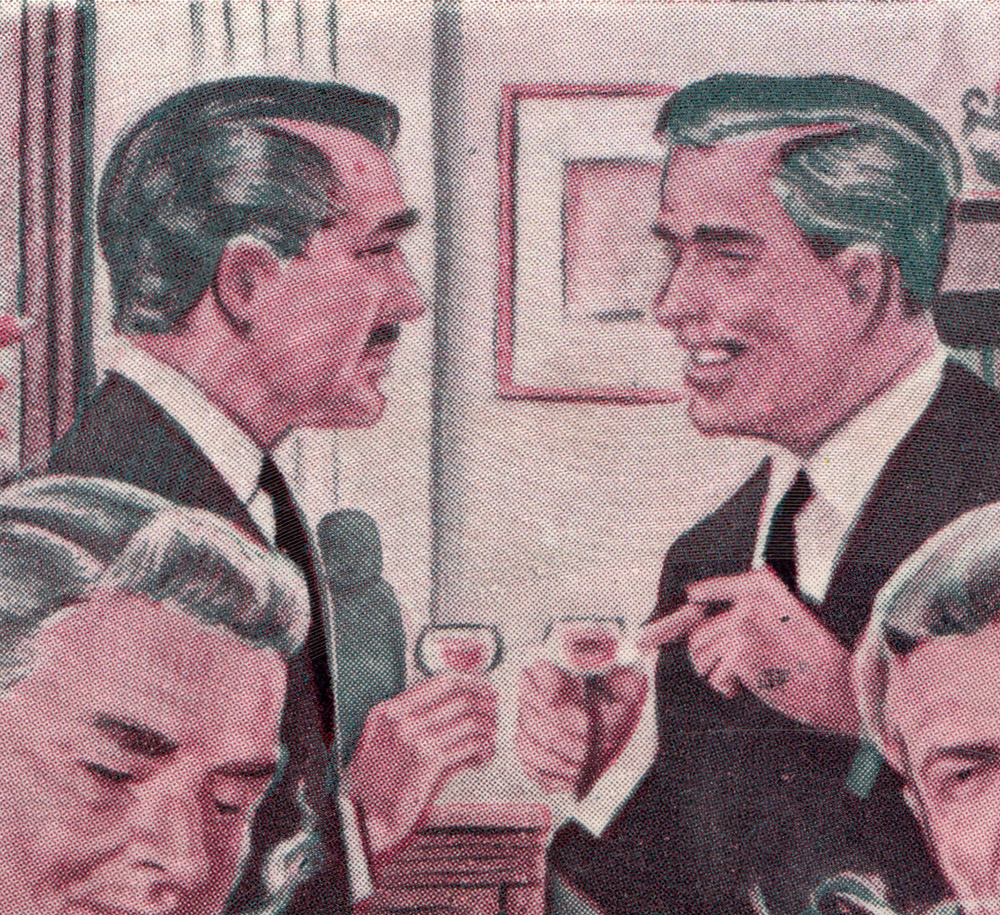
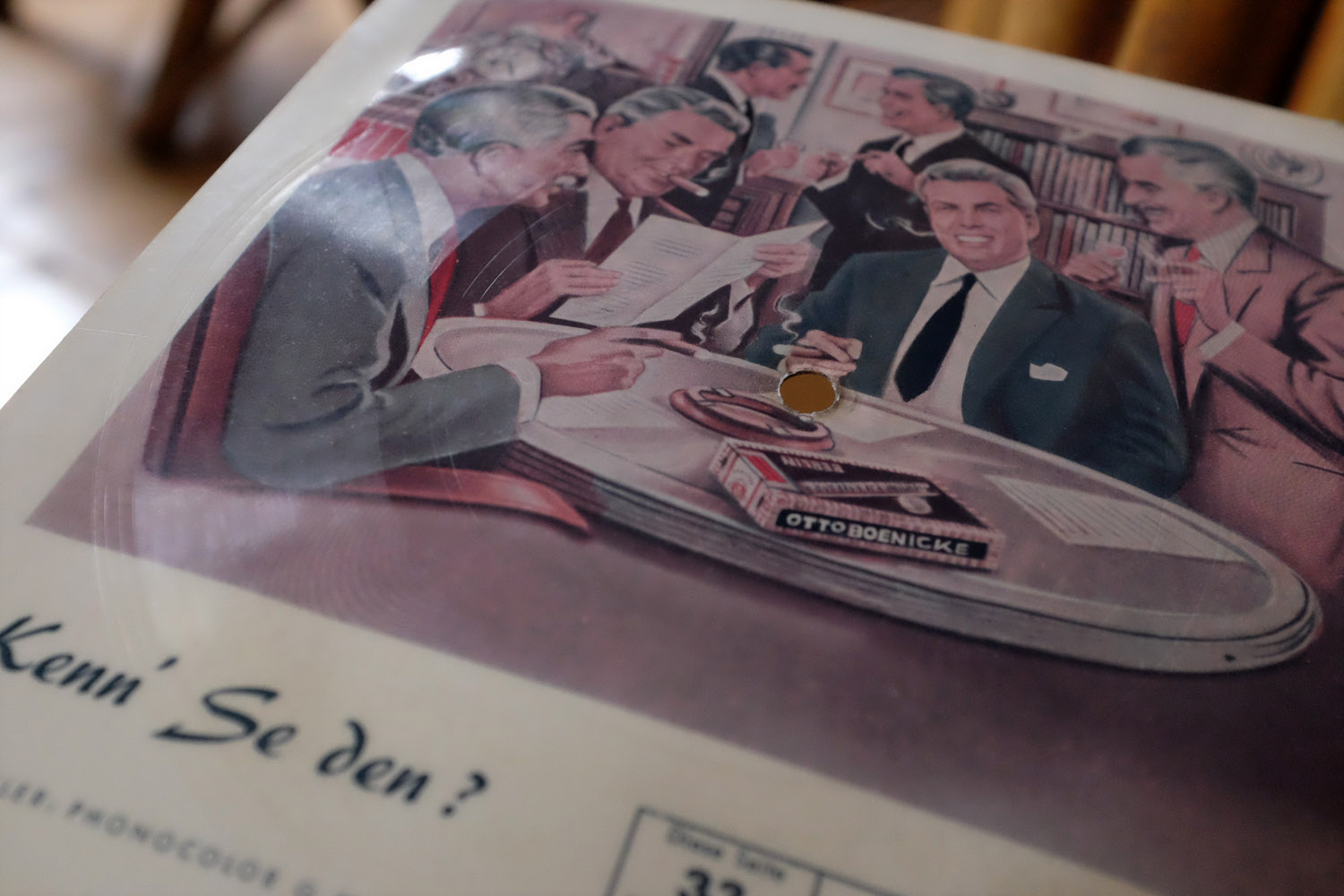
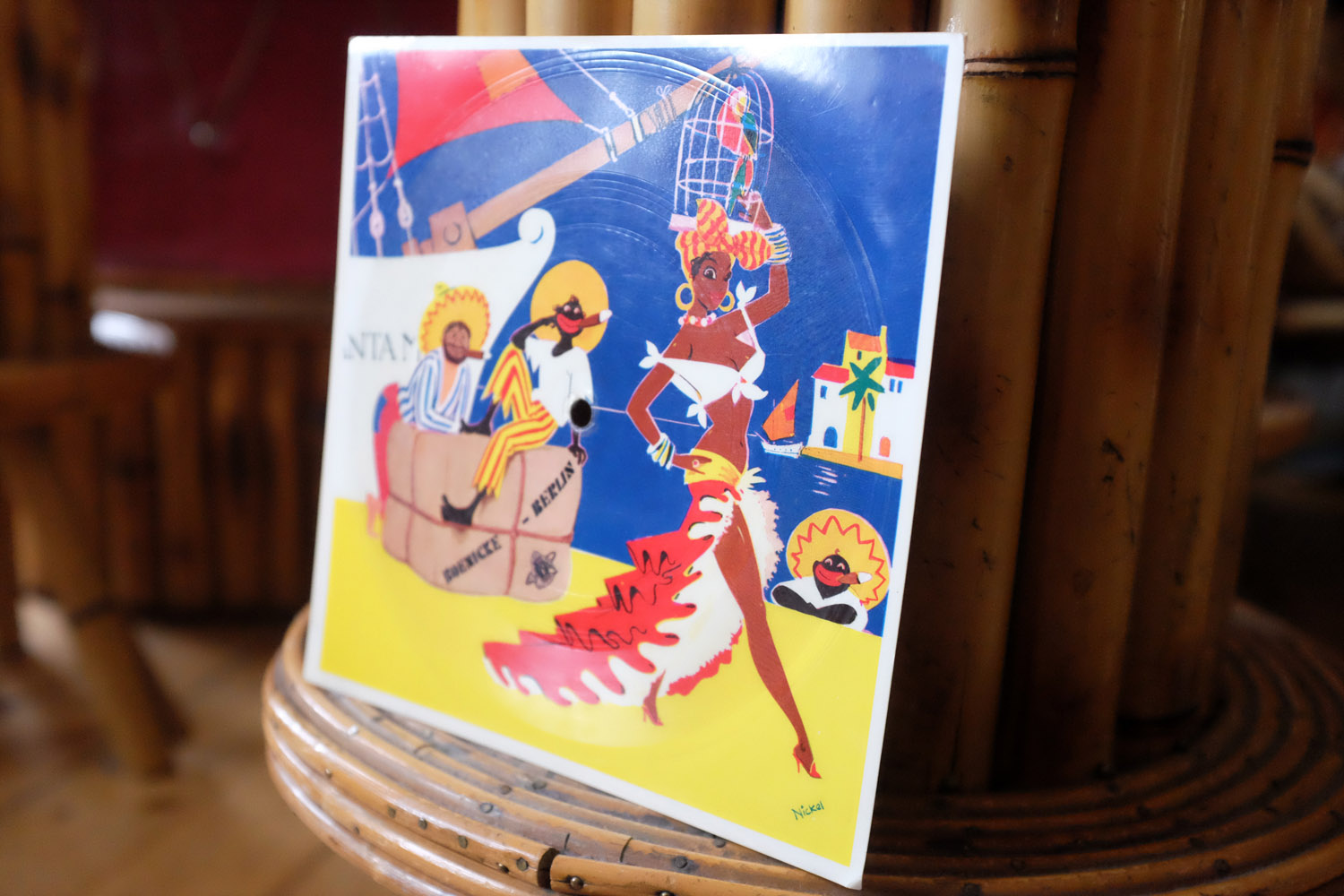
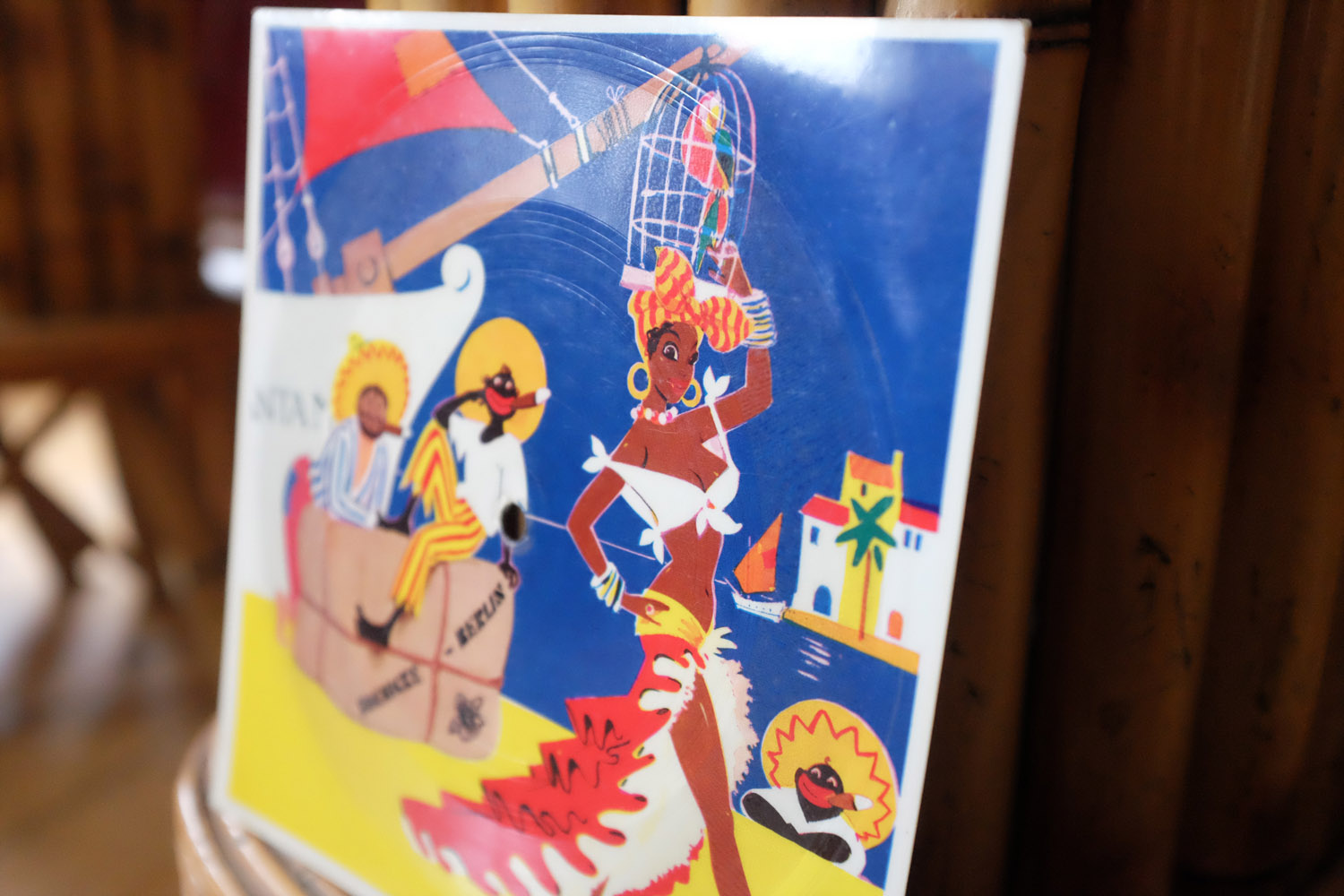





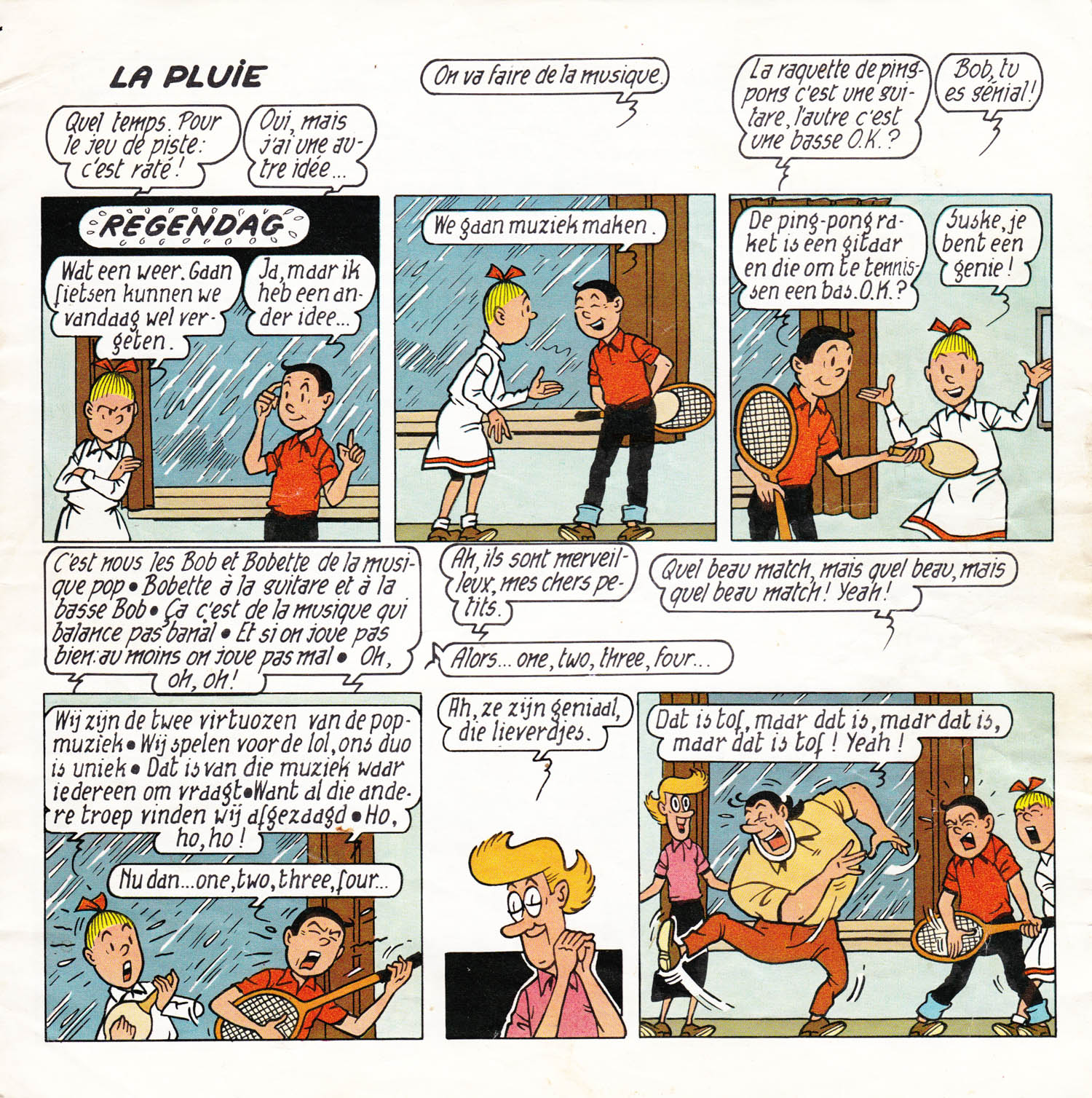














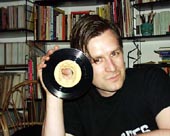 About me:
My name is Andreas Michalke. I´m a cartoonist from Berlin, Germany and I like collecting records. Most of the records I find in thrift stores or at flea markets here in Berlin. I like a lot of music but I thought I`d focus on odd German records. Preferably with cartoon covers.
All my scans are high-resolution. If you double-click on them they will get much bigger.
About me:
My name is Andreas Michalke. I´m a cartoonist from Berlin, Germany and I like collecting records. Most of the records I find in thrift stores or at flea markets here in Berlin. I like a lot of music but I thought I`d focus on odd German records. Preferably with cartoon covers.
All my scans are high-resolution. If you double-click on them they will get much bigger.
Recent Comments